Three New Alien Taxa for Europe and a Chorological Update on the Alien Vascular Flora of Calabria (Southern Italy)
Abstract
1. Introduction
2. Results
3. Discussion
4. Materials and Methods
5. Conclusions
Supplementary Materials
Author Contributions
Funding
Acknowledgments
Conflicts of Interest
Appendix A
- (1)
- Allium cepa L. [≡Allium ascalonicum auct., non L., Allium esculentum Salisb.]Amaryllidaceae Archeophyte Culton Bulbous geophyteFirst record for Calabria (casual)Observatum: 6 June 2019, Strada Comunale Amendolara (Reggio Calabria province), wheat field, 37.978678°N–15.818553°E, 348 m a.s.l., obs. et det. V.L.A. Laface.Note. Some flowering plants have been observed in a wheat field, which probably escaped cultivation from the vegetable gardens nearby. Casual alien in Abruzzo, Basilicata, Campania, Emilia-Romagna, Friuli Venezia Giulia, Lazio, Lombardia, Marche, Molise, Piemonte, Sardegna, Toscana, Umbria and Veneto, according to Galasso et al. [1].
- (2)
- Araujia sericiferaBrot. [≡Araujia albens (Mart.) G. Don, Araujia hortorum E. Fourn.]Apocynaceae Neophyte Southern America Climbing phanerophyteFirst geolocalized reports in Calabria (casual)Specimina: 4 July 2019, Catona (Reggio Calabria province), roadside climbed to a wire mesh, 38.174222°N–15.649700°E, 25 m a.s.l., leg. et det. V.L.A. Laface (REGGIO); 29 July 2019, Località Zonzoloso, Borgata Musa (Reggio Calabria province), roadside climbed to a wire mesh, 37.933149°N–15.753858°E, 57 m a.s.l., leg. et det. V.L.A. Laface (REGGIO).Note. A. sericifera is present in Italy as naturalized in Abruzzo and Sicilia, as casual in Lazio, Lombardia, Marche, Molise, Puglia, Sardegna, and Toscana, and as invasive in Campania [1]. In Calabria, this species was indicated as “recently not confirmed” by Celesti-Grapow et al. [87] and Galasso et al. [1], whereas was recently reported by Musarella et al. [44] for the same locality of Catona as casual, but in an unspecified uncultivated field. Recently, Lazzaro et al. [62] proposed this species for its inclusion in a national list of invasive species according to EU Regulation 1143/2014 [88].
- (3)
- Asparagus setaceus (Kunth) Jessop [≡Asparagopsis setacea Kunth]Asparagaceae Neophyte Southern Africa Climbing phanerophyteFirst record for Calabria (casual)Specimina: 2 March 2020, Località Bolano, tra Catona e Villa San Giovanni (Reggio Calabria province), citrus grove abandoned for many years, 38.203382°N–15.635614°E, 7 m a.s.l., leg. et det. V.L.A. Laface (REGGIO); 4 March 2020, Catona (Via Feudo) (Reggio Calabria province), climbed to a wire mesh, 38.185416°N–15.646368°E, 16 m a.s.l., leg. et det. V.L.A. Laface (REGGIO); 3 March 2020, Gallico Marina (Reggio Calabria province), abandoned citrus grove, 38.164632°N–15.649939°E, 9 m a.s.l., leg. et det. V.L.A. Laface (REGGIO); 11 May 2020, Catona (Reggio Calabria province), climbed to a wire mesh, 38.188973°N–15.642679°E, 37 m a.s.l., leg. et det. V.L.A. Laface (REGGIO).Observata: 3 March 2020, Gallico Inferiore (Reggio Calabria province), uncultivated garden, 38.166028°N–15.653223°E, 16 m a.s.l., obs. et det. V.L.A. Laface.Note. Used as an ornamental plant, probably escaped from the surrounding gardens. In the above localities, it was found in an old citrus grove and in abandoned lands where it also climbs over the existing trees. It is distributed in different regions of the Italian Peninsula as naturalized in Campania and Sicilia, whereas it is casual in Lazio, Puglia, Sardegna, Trentino-Alto Adige, and Toscana [1].
- (4)
- Bassia scoparia (L.) Voss [≡Chenopodium scoparia L.]Chenopodiaceae Neophyte Central Asia Scapose therophyteFirst record for Calabria (casual)Specimen: 21 October 2019, Via Torrente Carrò e Quattrone, Pellaro (Reggio Calabria province), roadside, 38.026944°N–15.656278°E, 16 m a.s.l., leg. et det. C.M. Musarella (REGGIO).Note. Widely used as an ornamental plant, particularly appreciated for the creation of low hedges, it is probably escaped from plants grown in pots or from nearby flowerbeds (observed by Musarella). B. scoparia is present throughout Italy as invasive, naturalized, or casual alien and not reported only for Molise and Basilicata [1].
- (5)
- Beta vulgaris L. subsp. vulgaris [≡Beta cicla L.; Beta esculenta Salisb.; Beta hortensis Mill.; Beta rapa Dumort.]Chenopodiaceae Archeophyte Culton Scapose hemicryptophyteFirst record for Calabria (naturalized)Specimen: 28 February 2020, Ortì Inferiore (Reggio Calabria province), orchard, 38.147958°N–15.709523°E, 604 m a.s.l., leg. et det. V.L.A. Laface (REGGIO).Observata: 26 January 2020, Via Provinciale Sant’Elia-Montebello Jonico (Reggio Calabria province), roadside, 37.954042°N–15.754001°E, 230 m a.s.l., obs. et det. V.L.A. Laface; 9 February 2020, C.da Pellegrino, Fiumara Acrifa (Reggio Calabria province), bergamot grove, 37.926021°N–15.839961°E, 17 m a.s.l., obs. et det. V.L.A. Laface; 9 February 2020, Bova Marina, vicino la Fiumara Amendolea (Reggio Calabria province), bergamot grove, 37.933048°N–15.893546°E, 17 m a.s.l., obs. et det. V.L.A. Laface; 19 January 2020, San Fantino (Reggio Calabria province), uncultivated field, 38.001735°N–15.817078°E, 329 m a.s.l., obs. et det. V.L.A. Laface; 22 January 2020, San Pantaleone Località Varada (Reggio Calabria province), uncultivated field, 37.989366°N–15.831174°E, 544 m a.s.l., obs. et det. V.L.A. Laface; 10 June 2019, Solano Superiore, Bagnara (Reggio Calabria province), roadside, 38.248756°N–15.794914°E, 653 m a.s.l., obs. et det. V.L.A. Laface.Note. B. vulgaris subsp. vulgaris is cultivated throughout Italy for food purposes. It grows abundantly in uncultivated and cultivated fields, in abandoned lands and on the edges of country roads. The subspecies is considered as a casual alien throughout Italy [1]. Several records above reported are known by Laface since about twenty years for their own domestic food uses.
- (6)
- Bidens formosa (Bonato) Sch. Bip. [≡Coreopsis formosa Bonato; Cosmos bipinnatus Cav., non Bidens bipinnata L.; Cosmos bipinnatus Cav.]Asteraceae Neophyte Northern and Central America Scapose therophyteFirst record for Calabria (casual)Specimina: 29 February 2020 Località Cazzeria, Catona (Reggio Calabria province), roadside, 38.191548°N–15.646137°E, 25 m a.s.l., leg. et det. V.L.A. Laface (REGGIO); 29 February 2020, Località Cazzeria, Catona (nei pressi del ponte dell’autostrada A3) (Reggio Calabria province), roadside, 38.192187°N–15.647553°E, 28 m a.s.l., leg. et det. V.L.A. Laface (REGGIO).Note. B. formosa is reported as a casual alien in regions of northern and central Italy [1].
- (7)
- Brugmansia aurea Lagerh. [≡Brugmansia pittieri (Saff.) Moldenke; Brugmansia affinis (Soff.) Moldenke]Solanaceae Neophyte Ecuador NanophanerophyteFirst record for Italy (casual)Specimen: 11 January 2020, S.S. Jonica 106, Galati, Brancaleone (Reggio Calabria province), roadside, 37.932976°N–16.069568°E, 8 m a.s.l., leg. et det. V.L.A. Laface (REGGIO).Note. Cultivated for ornamental purposes, very fragrant trumpet-shaped flowers, this plant is very attractive to bees, butterflies, and birds. Two plants were recorded along the road, mixed with Opuntia ficus-indica (L.) Mill. and Oxalis pes-caprae L. (Appendix B, Figure A2). In Europe, B. aurea was recorded only in Spain [89], therefore, this is the second report for Europe and the first for Italy.
- (8)
- Cascabela thevetia (L.) Lippold [≡Cascabela peruviana (Pers.) Raf.; Thevetia peruviana (Pers.) K. Schum.]Apocynaceae Neophyte Central and Southern America Frutescent chamaephyteFirst record for Europe (casual)Specimina: 5 October 2019, Melito di Porto Salvo (Reggio Calabria province), water drainage channel, 37.920423°N–15.802782°E, 9 m a.s.l., leg. et det. V.L.A. Laface (REGGIO); 19 October 2019, Fiumara Acrifa (Reggio Calabria province), near a fiumara, 37.920494°N-15.839534°E, 9 m a.s.l., leg. et det. V.L.A. Laface (REGGIO).Note. C. thevetia is an evergreen shrub native to tropical America (Mexico, Central America (Guatemala, Belize, El Salvador, Honduras, Nicaragua, Costa Rica, and Panama), South America (Colombia, Venezuela, British Guiana, Brazil, Ecuador, Peru, and Bolivia) and cultivated in the Antilles (Bahamas, Cuba, Haiti, Jamaica, Puerto Rico, and Dominican Republic), but it is widespread in the tropics around the world [90]. It is commonly cultivated as an ornamental plant and its flowering occurs throughout the year. Numerous seedlings have been found, born from seeds, in a water drainage channel and some adult plants along a wall, on the side of a typical little river (“fiumara”), mixed with Phyllostcahys aurea Carrière ex Rivière and C. Rivière (Appendix B, Figure A3). In Europe, it is reported as doubtful for Cyprus [91] and a preserved specimen is recorded for Portugal, but without a certain locality [92]. However, according to [83,84], C. thevetia is not given as present in Cyprus. Therefore, our finding represents the first European record.
- (9)
- Casuarina equisetifolia L.Casuarinaceae Neophyte Australia Scapose phanerophyteFirst record for Calabria (casual)Observata: 29 December 2019, Reggio Calabria (incrocio Via Aschenez-Via Willermin) (Reggio Calabria province), wall, 38.115494°N–15.654883°E, 35 m a.s.l., obs. et det. V.L.A. Laface; 18 January 2019, Straci, Marina di San Lorenzo (Reggio Calabria province), wall of a traditional water collection tank (“gebbia”), 37.923677°N–15.844383°E, 19 m a.s.l., obs. et det. V.L.A. Laface.Note. The plants observed were certainly generated by the seeds of some trees nearby planted, accidentally blown into the cracks in the walls (Appendix B, Figure A4). According to Galasso et al. [1], in Italy, this species is a casual alien in Lazio, Sicilia, Campania, and naturalized in Puglia and Toscana.
- (10)
- Cedrus atlantica (Endl.) G. Manetti ex Carrière [≡Pinus atlantica Endl.]Pinaceae Neophyte Northern Africa Scapose phanerophyteFirst record for Calabria (casual)Specimen: 9 May 2020, Piani di Reggio, Reggio Calabria (Reggio Calabria province), slope, 38.145513°N–15.803511°E, 1163m a.s.l., leg. et det. V.L.A. Laface.Observata: 6 May 2019, S.S. 184, Santo Stefano in Aspromonte (Reggio Calabria province), roadside and beech wood, 38.170283°N–15.828692°E, 1211m a.s.l., obs. et det. V.L.A. Laface.Note. According to Galasso et al. [1], in Italy, this species is a casual alien only in Sicilia and Basilicata.
- (11)
- Cenchrus setaceus (Forssk.) Morrone [≡Phalaris setacea Forssk.; Pennisetum setaceum (Forssk.) Chiov.]Poaceae Neophyte Northern and Eastern Africa and Arabian Peninsula Cespitose hemicryptophyteChange of status for Calabria: from naturalized to invasive (invasive)Specimina: 15 February 2020, Occhio di Pellaro (Reggio Calabria province), roadside, 38.043684°N–15.656055°E, 6 m a.s.l., leg. et det. C.M. Musarella (REGGIO); 8 May 2020, S.S. 106 (Reggio Calabria province), roadside, 38.064363°N–15.662721°E, 40 m a.s.l., leg. et det. C.M. Musarella (REGGIO); 17 May 2020, Saline Joniche (Reggio Calabria province), roadside, 37.944089°N–15.703504°E, 11 m a.s.l., leg. et det. V.L.A. Laface (REGGIO); 2 June 2020, C.da Venturi, Bova (Reggio Calabria province), roadside and uncultivated field, 37.937291°N–15.942257°E, 144 m a.s.l., leg. et det. V.L.A. Laface (REGGIO); 02-06-2020, Località Scilindermeno, Bova (Reggio Calabria province), roadside and wall, 37.953626°N–15.947259°E, 230 m a.s.l., leg. et det. V.L.A. Laface (REGGIO); 02-06-2020, Coddurena, Bova (Reggio Calabria province), roadside, 37.968476°N–15.947824°E, 398 m a.s.l., leg. et det. V.L.A. Laface (REGGIO).Note. C. setaceus is one of the “black” species present in the “Union list” of the European Union [86]. In Italy, this species is a casual alien in Calabria, Lazio, and Toscana, naturalized in Puglia, and invasive in Sardegna and Sicilia [1]. Subsequently, Musarella et al. [44] reported it as naturalized in Calabria. The specimens collected (S.S. 106 Occhio di Pellaro and Saline Joniche) along some city streets (Appendix B, Figure A5) probably come from some nearby villas or other spontaneous individuals geographically close. The new records reported here previously had not been observed by the authors, which means that they were born less than a year after previous reports by Musarella et al. [44].Reported for the first time in Calabria in 2007 [64], the species shows (as in other Italian regions) a strongly invasive character. C. setaceus was initially reported for this region by Celesti-Grapow et al. [87] and then confirmed by Musarella et al. [49] as casual. Recently, it was recorded as naturalized, according to Musarella et al. [44], but this species continues its uncontrollable expansion in Calabria and can therefore be considered as invasive.
- (12)
- Chlorophytum comosum (Thunb.) Jacques [≡Anthericum comosum Thunb.]Asparagaceae Neophyte Southern Africa Scapose hemicryptophyteFirst record for Calabria (casual)Specimina: 22 February 2020, Località Santa Maria, Ortì Inferiore (Reggio Calabria province), water drainage channel, 38.147425°N–15.711690°E, 608 m a.s.l., leg. et det. V.L.A. Laface (REGGIO); 22 February 2020, Località Santa Maria, Ortì Inferiore (Reggio Calabria province), rushes in an abandoned field, 38.147170°N–15.711247°E, 598 m a.s.l., leg. et det. V.L.A. Laface.Note. Several plants have been observed, most likely escaped from some pots nearby. The species has always been observed near wetlands. In Italy, this species is recorded as a casual alien in Abruzzo, Lombardia and Sardegna, and as naturalized in Campania [1].
- (13)
- Cucurbita maxima Duchesne subsp. maximaCucurbitaceae Neophyte Culton Scapose therophyteFirst record for Calabria (casual)Observata: 23 July 2019, Sambatello (Reggio Calabria province), roadside, 38.179022°N–15.694885°E, 297 m a.s.l., obs. et det. V.L.A. Laface; 06.06.2019, Ortì Inferiore (Reggio Calabria province), water drainage channel, 38.147552°N–15.710772°E, 604 m a.s.l., obs. et det. V.L.A. Laface.Note. C. maxima is locally cultivated for food purposes. Some flowering plants have been observed near water sources, likely to have escaped cultivation from nearby vegetable gardens. According to Galasso et al. [1], this subspecies is considered as a casual alien in northern Italy, in some regions of central Italy, and on the islands.
- (14)
- Dolichandra unguis-cati (L.) L.G. Lohmann [≡Bignonia unguis-cati L.; Macfadyena unguis-cati (L.) A.H. Gentry]Bignoniaceae Neophyte Southern America Climbing phanerophyteFirst record for Calabria (Casual)Specimina: 4 July 2019, Gallico (Reggio Calabria province), ruins, 38.146874°N–15.660094°E, 28 m a.s.l., leg. et det. V.L.A. Laface (REGGIO); 26 January 2020, Bova Marina (Reggio Calabria province), climbed to a wire mesh and ruins, 37.930419°N–15.915407°E, 9 m a.s.l., leg. et det. V.L.A. Laface (REGGIO); 26 January 2020, Località Vena, Bova Marina (Reggio Calabria province), climbing among the bricks of a bridge and in a water drainage channel, 37.929289°N–15.908896°E, 9 m a.s.l., leg. et det. V.L.A. Laface (REGGIO).Note. D. unguis-cati is present in Italy as a casual alien only in Campania, Lazio, Liguria, Sicilia, and Toscana [1].
- (15)
- Fagopyrum esculentum Moench [≡Fagopyrum sagittatum Gilib.; Fagopyrum vulgare Hill; Polygonum fagopyrum L.]Polygonaceae Neophyte Asia Scapose therophyteFirst record for Calabria (casual)Specimen: 5 May 2019, Lucia, Laganadi (Reggio Calabria province), roadside, 38.206843°N–15.756740°E, 388 m a.s.l., leg. et det. V.L.A. Laface (REGGIO).Note. Few plants were recorded along a road, mixed with Amaranthus sp. and Setaria sp., probably escaped from the cultivation of nearby gardens or vegetable gardens. In Italy, it is present in many regions as a casual alien (Abruzzo, Campania, Emilia-Romagna, Friuli Venezia Giulia, Lazio, Lombardia, Piemonte, Puglia, Trentino-Alto Adige, Umbria, and Veneto), whereas in Toscana it is naturalized [1].
- (16)
- Freesia alba (G.L. Mey.) Gumbl. [≡Freesia refracta var. alba G.L. Mey.; Freesia leichtlinii subsp. alba (G.L. Mey.) J.C. Manning & Goldblatt]Iridaceae Neophyte Southern Africa Bulbous geophyteFirst record for Calabria (casual)Specimina: 2 March 2020, Località San Cono, Rosalì (Reggio Calabria province), drywall limiting a “fiumara”, 38.202119°N–15.671522°E, 94 m a.s.l., leg. et det. V.L.A. Laface (REGGIO); 4 March 2020, Ortì Superiore (Reggio Calabria province), roadside, 38.151084°N–15.731452°E, 668 m a.s.l., leg. et det. V.L.A. Laface (REGGIO).Observata: 9 February 2020, Località Trabocchetto, Reggio Calabria (Reggio Calabria province), in a gutter, 38.108561°N–15.652622°E, 82 m a.s.l., obs. et det. V.L.A. Laface.
- (17)
- Ipomoea setosa Ker-Gawl. subsp. pavonii (Hallier f.) J.R.I. Wood & Scotland [≡Calonyction pavonii Hallier f.; Merremia pavonii (Hallier f.) D.F. Austin & Staples; Ipomoea setosa var. pavonii (Hallier f.) House]Convolvulaceae Neophyte Southern America Bulbous geophyteFirst record for Europe (casual)Specimen: 18 October2019, C.da La Monaca, Rizziconi (Reggio Calabria province), roadside, 38.418530°N–15.967880°E, 81 m a.s.l., leg. S. Cannavò, det. S. Cannavò, V.L.A. Laface, C.M. Musarella et G. Spampinato (REGGIO).Note. Recently, Wood et al. [81] published a monograph on Ipomoea genus in the New World. In it, the authors describe 425 taxa of Ipomoea and provide an identification key. According to these authors, the collected specimen from Rizziconi belong to I. setosa subsp. pavonii, a new recognized subspecies (comb. et stat. nov.). This subspecies is native to South America and it has fleshy trichomes on peduncles and pedicels, and these last are strongly swollen below the calyx. Its flowers have a short corolla of 5–6.5 cm [81]. Some details of the plants collected in Calabria are presented in Figure A6 of Appendix B. Until this record, Ipomoea setosa subsp. pavonii had not been recorded in Europe. Thus, our finding represents the first European record, according to Euro+Med PlantBase [83] and DAISIE (Inventory of alien invasive species in Europe) [sub Merremia pavonii (Hallier f.) D.F. Austin & Staples] [91].
- (18)
- Juglans regia L.Juglandaceae Cryptogenic Western Asia Scapose phanerophyteFirst record for Calabria (casual)Specimina: 16 February 2020, Cicala (Catanzaro province), escarpment, 39.024162°N–16.503332°E, 885 m a.s.l., leg. D. Grande, det. C.M. Musarella (REGGIO); 14 March 2020, Fiumara Catona, San Roberto (Reggio Calabria province), riverbed, 38.208153°N–15.754430°E, 374 m a.s.l., leg. et det. V.L.A. Laface (REGGIO); 09.05.2020, San Roberto (Reggio Calabria province), roadside, 38.208000°N–15.749657°E, 349 m a.s.l., leg. et det. V.L.A. Laface (REGGIO); 25 May 2020, Villaggio del Pino, Melia di Scilla, (Reggio Calabria province), roadside, 38.237782°N–15.737439°E, 600 m a.s.l., leg. et det. V.L.A. Laface (REGGIO); 25 May 2020, Solano (Reggio Calabria province), roadside, 38.251673°N–15.797604°E, 601 m a.s.l., leg. et det. V.L.A. Laface (REGGIO).Note: Some adult plants have been observed in both localities of Cicala and San Roberto, whereas juveniles were found in Solano and Melia di Scilla (Appendix B, Figure A7). In Italy, based on Galasso et al. [1], J. regia is present as naturalized in almost all regions of the Italian Peninsula or as cryptogenic in Sardegna, Lombardia, and Veneto, whereas it is absent only in Puglia. In Calabria, its use is known not only for their fruits as food but also for their leaves as an emollient for excessive feet perspiration [33,35] or to treat warts [34].
- (19)
- Kalanchoë delagoënsis Eckl. & Zeyh. [≡Bryophyllum delagoense (Eckl. & Zeyh.) Druce; Kalanchoë delagoensis Eckl. & Zeyh.]Crassulaceae Neophyte Southern Africa Succulent chamaephyteFirst record for Calabria (casual)Specimen: 15 February 2020, Via Sottolume, Pellaro (Reggio Calabria province), roadside, 38.021766°N–15.648545°E, 15 m a.s.l., leg. et det. C.M. Musarella (REGGIO).Note. Some plants have been observed on roadsides, probably originating from some nearby pots where the plant is grown. According to Galasso et al. [1], this species is present as a casual alien in Sicilia, Sardegna, Lazio, and Puglia.
- (20)
- Luffa aegyptiaca Mill. [≡Luffa cylindrica M. Roem., non-Momordica cylindrica L.; Momordica luffa L.]Cucurbitaceae Neophyte Southern Africa Scapose therophyteFirst record for Calabria and Italian Peninsula (casual)Specimen: 19 October 2019, Fiumara Acrifa (Reggio Calabria province), riverbed, 37.920592°N–15.839740°E, 9 m a.s.l., leg. et det. V.L.A. Laface (REGGIO).Note. Several plants have been found occupying a large part of the river (“fiumara”) and almost completely covered the vegetation below, characterized mainly by shrubs of Tamarix africana Poir (Appendix B, Figure A8). Based on Galasso et al. [1], L. aegyptiaca is present exclusively in Sicilia as a casual alien, therefore, this is the first report for Calabria and the Italian Peninsula.
- (21)
- Narcissus ‘Cotinga’Amaryllidaceae Neophyte Culton Bulbous geophyteFirst record for Italy (naturalized)Specimina: 27 April 2019, Piani di Reggio (Reggio Calabria province), grazing-meadow covered with broom, 38.136339°N–15.823482°E, 1313 m a.s.l., leg. et det. V.L.A. Laface (REGGIO); 14 March 2020, Podargoni (Reggio Calabria province), abandoned walnut grove, 38.164593°N–15.780524°E, 543 m a.s.l., leg. V.L.A. Laface, det. C.M. Musarella (REGGIO).
- (22)
- Narcissus ‘Erlicheer’Amaryllidaceae Neophyte Culton Bulbous geophyteFirst record for Italy (casual)Specimen: 24 January 2020, Via Torrente Carrò e Quattrone, Pellaro (Reggio Calabria province), roadside, 38.027402°N–15.657049°E, 18 m a.s.l. leg. et det. C.M. Musarella (REGGIO).
- (23)
- Nothoscordum gracile (Aiton) Stearn [≡Allium gracile Aiton; Nothoscordum inodorum (Aiton) G. Nicholson; Nothoscordum borbonicum sensu Auct. Fl. Ital., non Kunth]Amaryllidaceae Neophyte Southern America Bulbous geophyteChange of status for Calabria: from casual to invasive (invasive)Specimina: 5 March 2020, Archi Carmine (Reggio Calabria province), roadside, 38.155941°N–15.662968°E, 34 m a.s.l., leg. et det. V.L.A. Laface (REGGIO); 9 May 2020, Catona (Reggio Calabria province), roadside, 38.187991°N–15.640659°E, 9 m a.s.l., leg. et det. V.L.A. Laface (REGGIO); 9 May 2020, Catona (Reggio Calabria province), roadside, 38.186554°N–15.639327°E, 5 m a.s.l., leg. et det. V.L.A. Laface (REGGIO); 09 May 2020, Catona (Reggio Calabria province), roadside, 38.185641°N–15.638498°E, 3 m a.s.l., leg. et det. V.L.A. Laface (REGGIO); 9 May 2020, Catona (Reggio Calabria province), roadside, 38.182539°N–15.640183°E, 1 m a.s.l., leg. et det. V.L.A. Laface (REGGIO); 9 May 2020, Catona (Reggio Calabria province), roadside, 38.173234°N–15.640023°E, 1 m a.s.l., leg. et det. V.L.A. Laface (REGGIO); 10 May 2020, Località San Francesco, Catona (Reggio Calabria province), roadside, 38.181355°N–15.647343°E, 23 m a.s.l., leg. et det. V.L.A. Laface (REGGIO); 10 May 2020, Gallico Inferiore (Reggio Calabria province), roadside, 38.172231°N–15.651144°E, 34 m a.s.l., leg. et det. V.L.A. Laface (REGGIO); 10 May 2020, Gallico Inferiore (Reggio Calabria province), roadside, 38.172078°N–15.651199°E, 23 m a.s.l., leg. et det. V.L.A. Laface (REGGIO); 10 May 2020, Località S. Antonino, Gallico Inferiore (Reggio Calabria province), roadside, 38.169784°N–15.651662°E, 18 m a.s.l., leg. et det. V.L.A. Laface (REGGIO); 10 May 2020, Gallico Inferiore (Reggio Calabria province), roadside and wall, 38.167760°N–15.652999°E, 19 m a.s.l., leg. et det. V.L.A. Laface (REGGIO); 10-05-2020, Ponte Itria, Gallico Inferiore (Reggio Calabria province), roadside, 38.164272°N–15.654143°E, 15 m a.s.l., leg. et det. V.L.A. Laface (REGGIO); 10 May 2020, Gallico Inferiore (Reggio Calabria province), roadside, 38.158512°N–15.656363°E, 15 m a.s.l., leg. et det. V.L.A. Laface (REGGIO); 10 May 2020, Scaccioti, Archi (Reggio Calabria province), roadside, 38.156560°N–15.660512°E, 26 m a.s.l., leg. et det. V.L.A. Laface (REGGIO); 10 May 2020, Campo Calabro (Reggio Calabria province), roadside, 38.215613°N–15.658041°E,139 m a.s.l., leg. et det. V.L.A. Laface (REGGIO); 10 May 2020, Campo Calabro (Reggio Calabria province), roadside, 38.215233°N–15.656918°E, 142 m a.s.l., leg. et det. V.L.A. Laface (REGGIO); 10 May 2020, Concessa (Reggio Calabria province), roadside, 38.193435°N–15.641554°E, 30 m a.s.l., leg. et det. V.L.A. Laface (REGGIO); 10 May 2020, Concessa (Reggio Calabria province), roadside, 38.192726°N–15.641197°E, 33 m a.s.l., leg. et det. V.L.A. Laface (REGGIO); 10 May 2020, Concessa (Reggio Calabria province), roadside, 38.192295°N–15.640988°E, 24 m a.s.l., leg. et det. V.L.A. Laface (REGGIO); 10 May 2020, Concessa (Reggio Calabria province), roadside, 38.192072°N-15.640936°E, 22 m a.s.l., leg. et det. V.L.A. Laface (REGGIO); 10 May 2020, Villa San Giovanni (Reggio Calabria province), roadside, 38.215063°N–15.638823°E, 27 m a.s.l., leg. et det. V.L.A. Laface (REGGIO); 8 May 2020, Lazzaro (Reggio Calabria province), roadside, 37.974493°N–15.664018°E, 17 m a.s.l., leg. et det. C.M. Musarella (REGGIO); 08 May 2020, Lazzaro (Reggio Calabria province), roadside, 37.974547°N–15.664240°E, 18 m a.s.l., leg. et det. C.M. Musarella (REGGIO); 8 May 2020, Lazzaro (Reggio Calabria province), roadside, 37.974068°N–15.664895°E, 17 m a.s.l., leg. et det. C.M. Musarella (REGGIO); 8 May 2020, Lazzaro (Reggio Calabria province), roadside, 37.974218°N–15.665000°E, 18 m a.s.l., leg. et det. C.M. Musarella (REGGIO); 13 May 2019, Viale Umberto Zanotti Bianco, Villa San Giovanni (Reggio Calabria province), sidewalk, 38.214597°N–15.637022°E, 8 m a.s.l., obs. et det. V.L.A. Laface (REGGIO); 13 May 2020, Viale Umberto Zanotti Bianco, Villa San Giovanni (Reggio Calabria province), roadside, 38.213352°N–15.636946°E, 10 m a.s.l., leg. et det. V.L.A. Laface (REGGIO); 13 May 2020, Viale Umberto Zanotti Bianco, Villa San Giovanni (Reggio Calabria province), roadside, 38.212765°N–15.637123°E, 9 m a.s.l., leg. et det. V.L.A. Laface (REGGIO); 13 May 2020, Acciarello, Villa San Giovanni (Reggio Calabria province), roadside, 38.208752°N–15.635923°E, 9 m a.s.l., leg. et det. V.L.A. Laface (REGGIO); 13 May 2020, Bolano, tra Catona e Villa S. Giovanni (Reggio Calabria province), roadside, 38.205922°N–15.635899°E, 5 m a.s.l., leg. et det. V.L.A. Laface (REGGIO); 13 May 2020, Spontone, Catona (Reggio Calabria province), roadside, 38.192740°N–15.636915°E, 11 m a.s.l., leg. et det. V.L.A. Laface (REGGIO); 13 May 2020, Sambatello (Reggio Calabria province), roadside, 38.177942°N–15.690210°E, 270 m a.s.l., leg. et det. V.L.A. Laface (REGGIO).Note. N. gracile has been observed growing in the crevices of sidewalks, probably escaped from nearby pots or flower beds. In Italy, it is present as naturalized in Campania, Toscana, and Puglia and as a casual alien in Liguria, Piemonte, and Sardegna [1]. N. gracile was recently reported in Calabria by Rosati et al. [52] as casual in Lazzaro (Reggio Calabria province). In several locations reported here in Specimina (and in particular in Lazzaro), this species has spread everywhere, especially along the edges of the streets. Therefore, due to its rapid spread, we propose here the new status of invasive.
- (24)
- Oxalis stricta L. [≡Oxalis europaea Jord.; Oxalis fontana Bunge; Xanthoxalis stricta (L.) Small; Oxalis corniculate var. stricta (L.) C.C. Huang & L.R. Xu; Oxalis stricta f. lejeunei Rouy, Oxalis chinensis Haw. ex G. Don; Oxalis cymose Small; Oxalis lejeunei (Rouy) A.W. Hill; Xanthoxalis cymose (Small) Small; Xanthoxalis europaea (Jord.) Moldenke; Xanthoxalis fontana (Bunge) Holub]Oxalidaceae Neophyte Northern America Scapose hemicryptophyteConfirmation for Calabria (casual)Specimen: 14 March 2020, Via della Fonderia, Catona (Reggio Calabria province), sidewalk in a roadside, 38.189965°N–15.644670°E, 17 m a.s.l., leg. et det. V.L.A. Laface (REGGIO).Observata: 4 March 2020, Occhio di Pellaro (Reggio Calabria province), sidewalk, 38.035157°N–15.657916°E, 7 m a.s.l., obs. et det. V.L.A. Laface; 28 March 2020, Ortì Inferiore (Reggio Calabria province), between the steps of a stairway, 38.147584°N–15.711343°E, 610 m a.s.l., obs. et det. V.L.A. Laface.Note. O. stricta grows in the crevices of the walls and sidewalks. It was probably introduced through nurseries or horticultural material. This species is naturalized or invasive in northern Italy and in some regions of central Italy, whereas it is reported as doubtful for Calabria [1]. Our record confirms its presence in the region.
- (25)
- Passiflora caerulea L.Passifloraceae Neophyte Southern America Climbing phanerophyteFirst record for Calabria (casual)Specimen: 13 September 2019, SP1 Taurianova-Cittanova (Reggio Calabria province), roadside, climbed to a wire mesh, 38.352809°N–16.058705°E, 355 m a.s.l., leg. et det. V.L.A. Laface (REGGIO).Note. Species native to South America, introduced as an ornamental species together with numerous species of the genus Passiflora [93]. The only plant found grew by climbing on the wire mesh of an olive grove, very far from inhabited areas. The seeds were probably transported there by birds or small mammals as the fruits are very appetizing to wildlife. P. caerulea is reported as a casual alien in almost all regions of Italy (Abruzzo, Basilicata, Friuli Venezia Giulia, Lazio, Liguria, Lombardia, Marche, Molise, Puglia, Sardegna, Sicilia, Trentino-Alto Adige, Umbria, and Veneto). It is naturalized only in Toscana and Campania [1].
- (26)
- Portulaca grandiflora Hook.Portulacaceae Neophyte Southern America Scapose therophyteFirst record for Calabria (casual)Observata: 29 July 2019, Via Mercato, Catona (Reggio Calabria province), roadside, 38.185898°N–15.638733°E, 4 m a.s.l., obs. et det. V.L.A. Laface; 25 July 2019, Via Nazionale, Catona (Reggio Calabria province), sidewalk, 38.178500°N–15.648642°E; 18 m a.s.l., obs. et det. V.L.A. Laface.Note. P. grandiflora cultivated for ornamental purposes in pots and flower beds produces very showy and colorful flowers. The plants observed grew in the crevices of the sidewalk. The species easily reproduces by seed, it is likely that the observed plants are derived from the seeds of pots and flowerbeds nearby. It was previously recorded as a casual alien in Emilia Romagna, Lazio, Liguria, Lombardia, Marche, Piemonte, Sardegna, Trentino Alto Adige, and Veneto, whereas it is naturalized only in Sicilia [1].
- (27)
- Prunus armeniaca L.Rosaceae Archeophyte Culton Scapose phanerophyteFirst record for Calabria (casual)Specimen: 4 April 2019, Piani di San Nicola, Ortì (Reggio Calabria province), olive grove, 38.151968°N–15.695646°E, 560 m a.s.l., leg. et det. V.L.A. Laface (REGGIO).Note. P. armeniaca reproduces very easily by seed, often transported by man. It was not previously recorded as a casual alien species in Italy only for Valle d’Aosta, Puglia, and Friuli Venezia Giulia [1].
- (28)
- Prunus dulcis (Mill.) D.A. Webb [≡Amygdalus dulcis Mill.]Rosaceae Archeophyte Feral Scapose phanerophyteFirst record for Calabria (casual)Specimina: 6 February 2020, C.da Fornace, Strada Gallina-Santa Venere (Reggio Calabria province), near an abandoned almond grove, 38.075486°N–15.724071°E, 491 m a.s.l., leg. et det. V.L.A. Laface (REGGIO); 13 September 2019, C.da Pietra, San Carlo (Reggio Calabria province), rocks emerging from the ground, 37.944144°N–15.864352°E, 173 m a.s.l., leg. et det. V.L.A. Laface (REGGIO); 13 September 2019, C.da Pietra, San Carlo (Reggio Calabria province), rocks emerging from the ground, 37.943588°N–15.864148°E, 172 m a.s.l., leg. et det. V.L.A. Laface (REGGIO); 13 September 2019, C.da Monte Callea (Reggio Calabria province), uncultivated field, 37.935116°N–15.922699°E, 76 m a.s.l., leg. et det. V.L.A. Laface (REGGIO); 19 May 2020, C.da Cambareri (Reggio Calabria province), roadside, 38.000372°N–15.676193°E, 357 m a.s.l., leg. et det. V.L.A. Laface (REGGIO); 19 May 2020 Motta San Giovanni (Reggio Calabria province) roadside, 37.999761°N–15.685197°E, 414 m a.s.l., leg. et det. V.L.A. Laface (REGGIO).Observata: 6 February 2020, Aretina Superiore (Reggio Calabria province), roadside, 38.068723°N–15.705494°E, 368 m a.s.l., obs. et det. V.L.A. Laface; 9 June 2020, Aretina Superiore (Reggio Calabria province), roadside, 38.099403°N–15.722838°E, 380 m a.s.l., obs. et det. V.L.A. Laface and CM Musarella.Note. Fruit tree cultivated mainly for the production of almonds, P. dulcis is used as food and in the confectionery industry. The species spreads rapidly by seed; all plants found were grown near almond groves nearby. According to Galasso et al. [1], this species is a casual alien throughout Italy excluding Lombardia, Valle d’Aosta, and Puglia where the species is naturalized.
- (29)
- Salpichroa origanifolia (Lam.) Baill. [≡Physalis origanifolia Lam.]Solanaceae Neophyte Southern America Frutescent chamaephyteChange of status for Calabria: from naturalized to invasive (invasive)Specimina: 5 January 2020, Reggio Calabria (Reggio Calabria province), roadside, climbed to a wire mesh, 38.122064°N–15.664753°E, 59 m a.s.l., leg. G. Messineo, det. C.M. Musarella (REGGIO); 21 February 2020, Pentimele (Reggio Calabria province), roadside, climbed to a wire mesh, 38.142236°N–15.656332°E, 18 m a.s.l., leg. et det. C.M. Musarella (REGGIO); 4 March 2020, Catona (Reggio Calabria province), roadside, climbed to a wire mesh, 38.174193°N–15.649876°E, 27 m a.s.l., leg. et det. V.L.A. Laface (REGGIO); 3 March 2020, Gallico Inferiore (Reggio Calabria province), roadside, climbed to a wire mesh and on the wall of an old house, 38.166172°N–15.653259°E, 16 m a.s.l., leg. et det. V.L.A. Laface (REGGIO); 3 March 2020, Gallico Inferiore (Reggio Calabria province), climbed to a wire mesh and grow in uncultivated garden, 38.165846°N–15.652497°E, 14 m a.s.l., leg. et det. V.L.A. Laface (REGGIO); 3 March 2020, Gallico Inferiore (Reggio Calabria province) climbed to a wire mesh, 38.164773°N–15.650404°E, 9 m a.s.l., leg. et det. V.L.A. Laface (REGGIO); 3 March 2020, Fiumara Scaccioti (Reggio Calabria province), climbing on the bridge span, 38.156481°N–15.657227°E, 18 m a.s.l., leg. et det. V.L.A. Laface (REGGIO).Observata: 17 January 2020, Bolano, tra Catona e Villa San Giovanni (Reggio Calabria province), roadside, climbed to a wire mesh, 38.195878°N–15.636748°E, 15 m a.s.l., obs. et det. V.L.A. Laface; 10 February 2020, Marinella di Catona (Reggio Calabria province), roadside, climbed to a wire mesh, 38.192642°N–15.635087°E, 4 m a.s.l., obs. et det. V.L.A. Laface; 10 February 2020, Spontone (Reggio Calabria province), roadside, climbed to a wire mesh, 38.194584°N–15.635778°E, 5 m a.s.l., obs. et det. V.L.A. Laface.Note. Species already known for Calabria, it has recently been reported as naturalized for the region [49]. The plants observed often grow by climbing on wire mesh in very anthropized areas. In Italy, according to Galasso et al. [1], S. origanifolia is naturalized in Abruzzo, Calabria, Lazio, Marche, Piemonte, Puglia, Sicilia, Toscana, Umbria, invasive in Campania, and casual in Emilia-Romagna, Liguria, and Sardegna. For the several new stations found in which this species is so widespread and reproduces itself, we propose here the change of status from naturalized to invasive for Calabria.
- (30)
- Sesbania punicea (Cav.) Benth. [≡Piscidia punicea Cav.]Fabaceae Neophyte Southern America Scapose phanerophyteChange of status for Calabria: from naturalized to invasive (invasive)Specimen: 21 August 2019, Lamezia Terme (Catanzaro province), 9 m a.s.l., in a water drainage channel near the airport, between the way and a cultivated field, 38.910900°N–16.252251°E, leg. et det. C.M. Musarella (REGGIO).Note. Recently reported as naturalized for Calabria in the province of Cosenza in 2015 [94], this is the second record for the region of S. punicea. This alien species shows a high degree of invasiveness in the new locality; it occupies more or less 100 m in length of a narrow water drainage channel along a road. The plants found were flowering and fruiting and several seedlings were also growing (Appendix B, Figure A9). For this reason, due to its rapid widespread and continuous reproduction, we propose the new status of invasive.
- (31)
- Solanum tuberosum L.Solanaceae Neophyte Culton Scapose therophyteFirst record for Calabria (casual)Specimen: 11 January 2020, Sambatello (incrocio tra Via 25 Luglio e S.P.7) (Reggio Calabria province), roadside, water drainage channel, 38.179731°N–15.694848°E, 299 m a.s.l., leg. et det. V.L.A. Laface (REGGIO).Note. The sampled plant has probably escaped cultivation from nearby gardens or inadvertently been thrown by man and subsequently transported by water. S. tuberosum is reported for all Italian regions as a casual alien excluding Valle d’Aosta, Liguria, Basilicata, and Sicilia [1].
- (32)
- Tecoma stans (L.) Juss. ex Kunth [≡Bignonia stans L.; Stenolobium stans (L.) D. Don; Tecoma stans (L.) Kunth var. stans; Tecoma stans (L.) Kunth var. velutina DC.]Bignoniaceae Neophyte Northern America Climbing phanerophyteFirst record for Europe (casual)Specimen: 19 October 2019, Svincolo Bocale - S.S. Jonica 106 (Reggio Calabria province), sidewalk, 37.987339°N–15.651794°E, 12 m a.s.l., leg. et det. V.L.A. Laface (REGGIO).Note. Native to southern USA, Mexico, the Caribbean, Peru, and Ecuador [93]. The dispersion occurs mainly through winged seeds dispersed by the wind, produced in large quantities almost all year round [95,96]. The plant observed probably originates from seeds of nearby houses, grown in the cracks of the sidewalk near a high traffic state road (Appendix B, Figure A10). Widely spread worldwide, T. stans is reported in Europe only for Malta as T. stans var. sambucifolia [97], whereas it is not given as present in Malta according to Euro+Med PlantBase [83]. Therefore, we consider this as the first report for Europe.
- (33)
- Tradescantia sillamontana MatudaCommelinaceae Neophyte Southern America Rhizome geophyteFirst record for Calabria (casual)Observata: 1 December 2019, C.da Monte Callea (Reggio Calabria province), uncultivated field, 37.935131°N–15.922646°E, 76 m a.s.l., obs. et det. V.L.A. Laface (REGGIO).Note. Succulent species cultivated as an ornamental plant for its characteristic “hairy” leaves, it reproduces easily by vegetative way, and the plant probably escaped the cultivation from the nearby villas, after being thrown together with waste material (Appendix B, Figure A11). After the first record for Italy in Campania [98], this is the second one for the country and the first for Calabria.
- (34)
- Washingtonia filifera (Linden ex André) H. Wendl. ex de Bary [≡Pritchardia filifera Linden ex André]Arecaceae Neophyte Northern America Scapose phanerophyteFirst record for Calabria (casual)Specimen: 10 January 2020, lungo la strada tra i dipartimenti di Agraria e di Ingegneria (Reggio Calabria province), sidewalk, 38.120043°N–15.666549°E, 85 m a.s.l., leg. et det. V.L.A. Laface (REGGIO).Note. Several individuals were found along a sidewalk. The seeds that are highly appetizing to birds are transported even at great distances. W. filifera has no particular ecological needs; it adapts easily to growing even in unfavorable conditions and is often found in the cracks in the walls and sidewalks. In Italy, based on Galasso et al. [1], the species is a casual alien in Abruzzo, Campania, Liguria, Puglia, Sardegna, and is naturalized in Sicilia. Recently, Lazzaro et al. [60] proposed this species for its inclusion on a national list of invasive species according to Regulation (EU) No. 1143/2014.
Appendix B
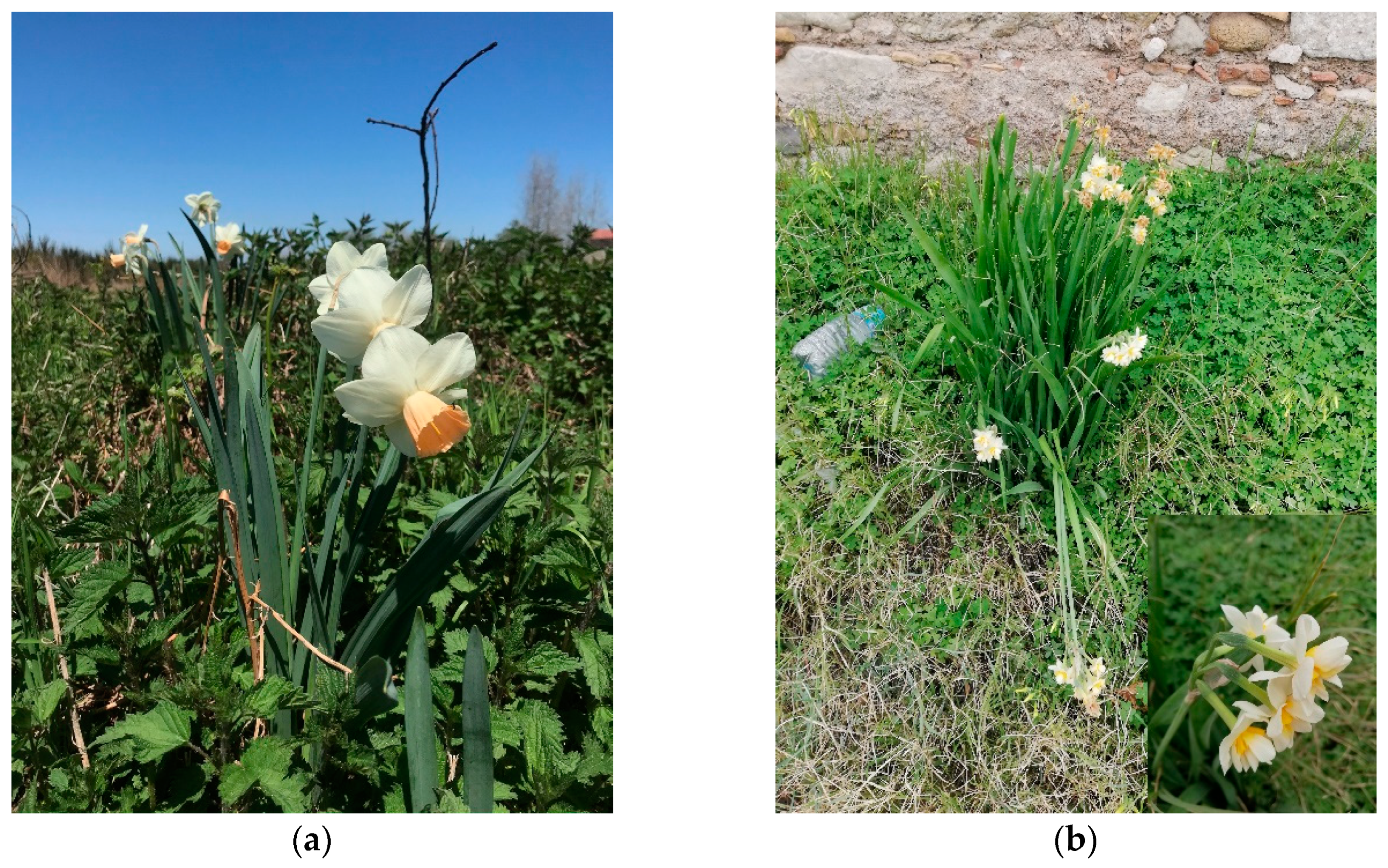
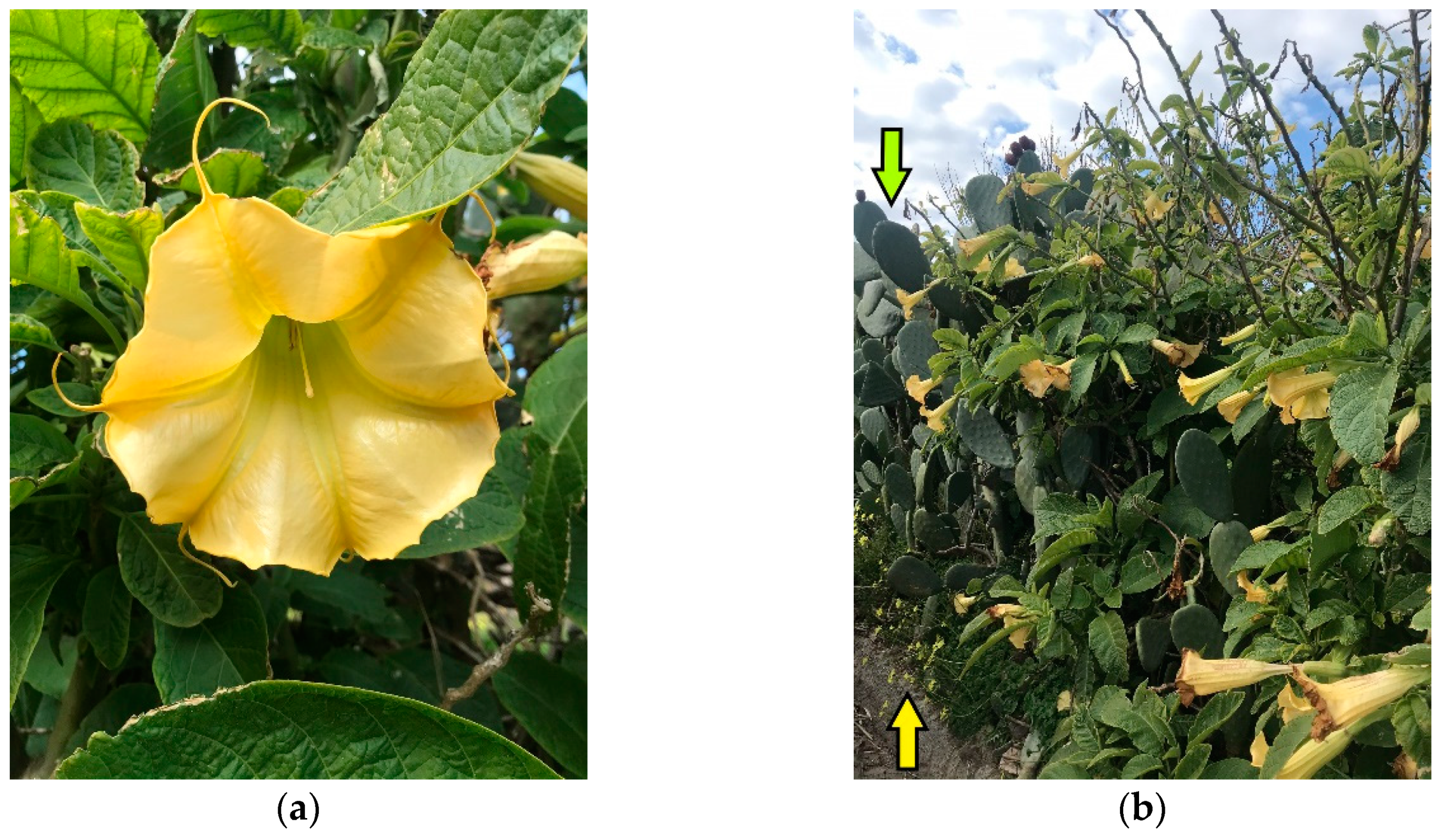
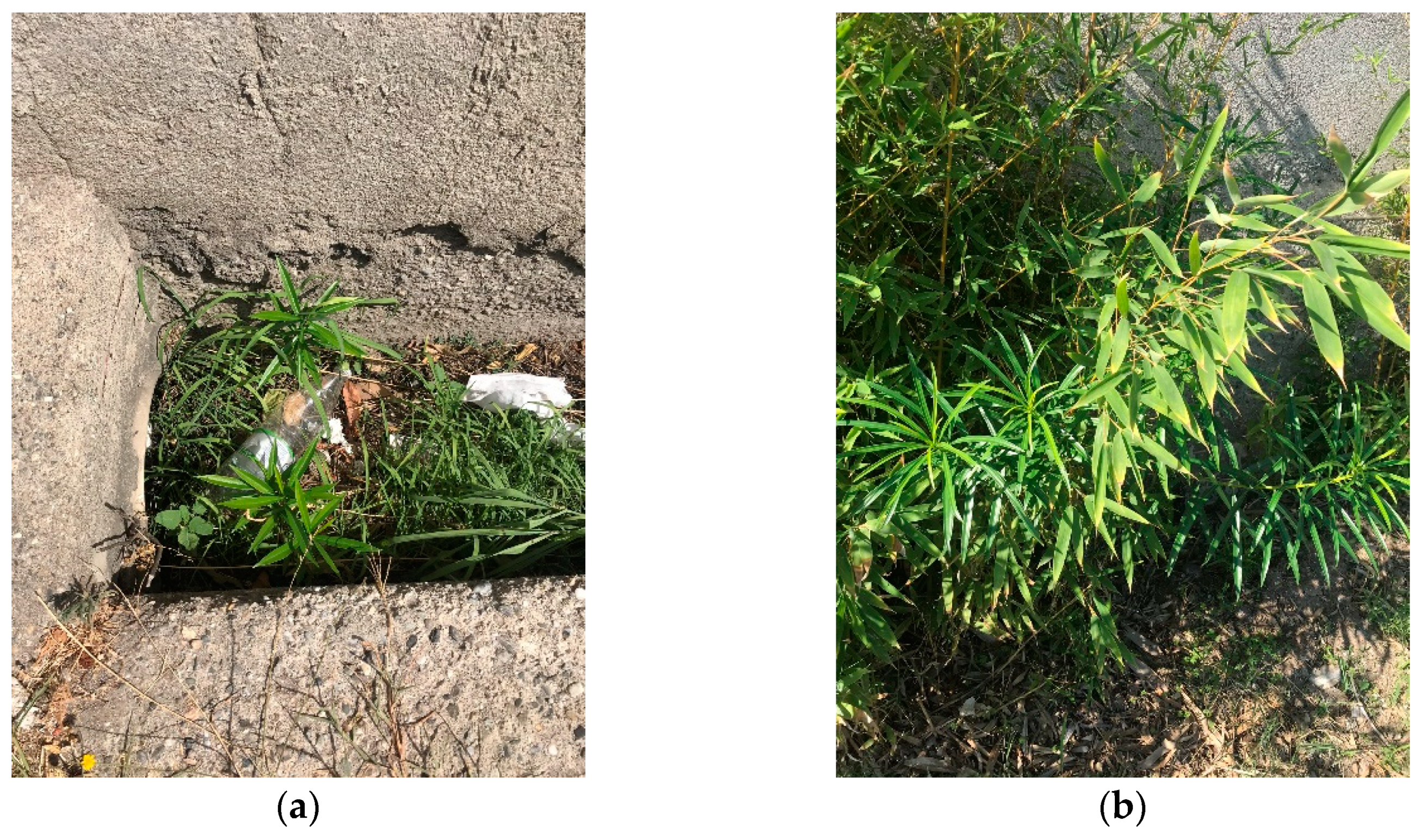
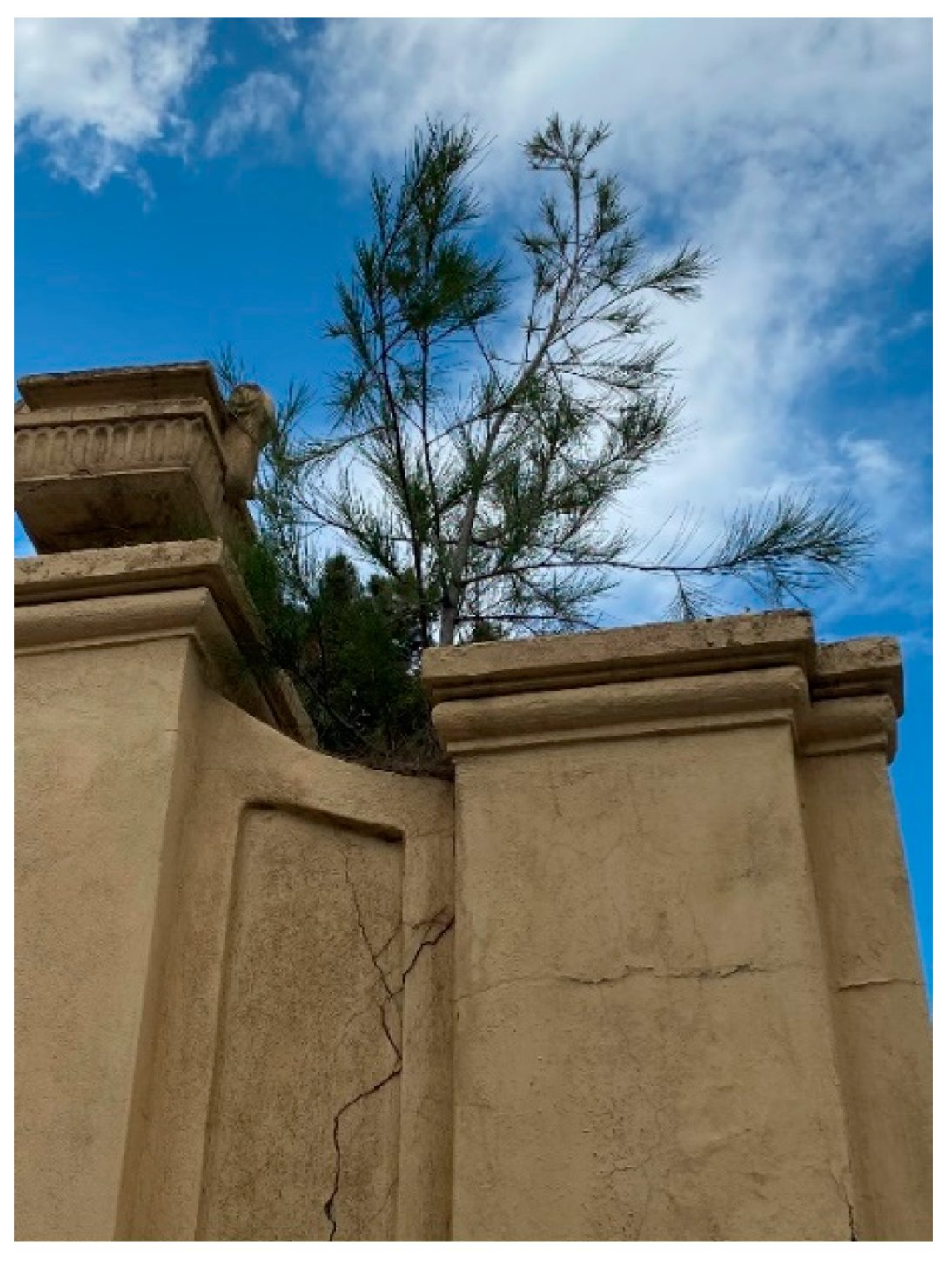
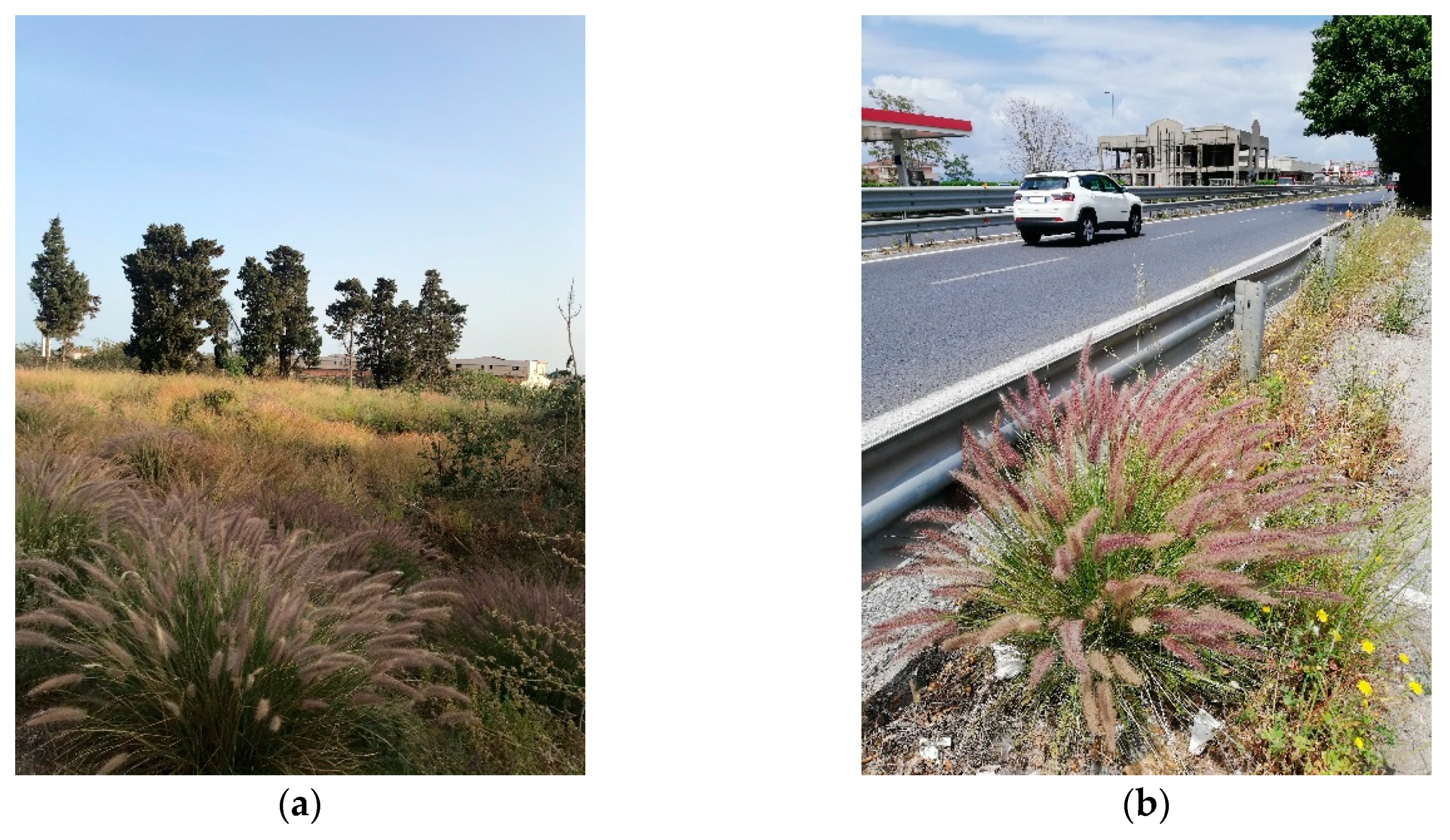

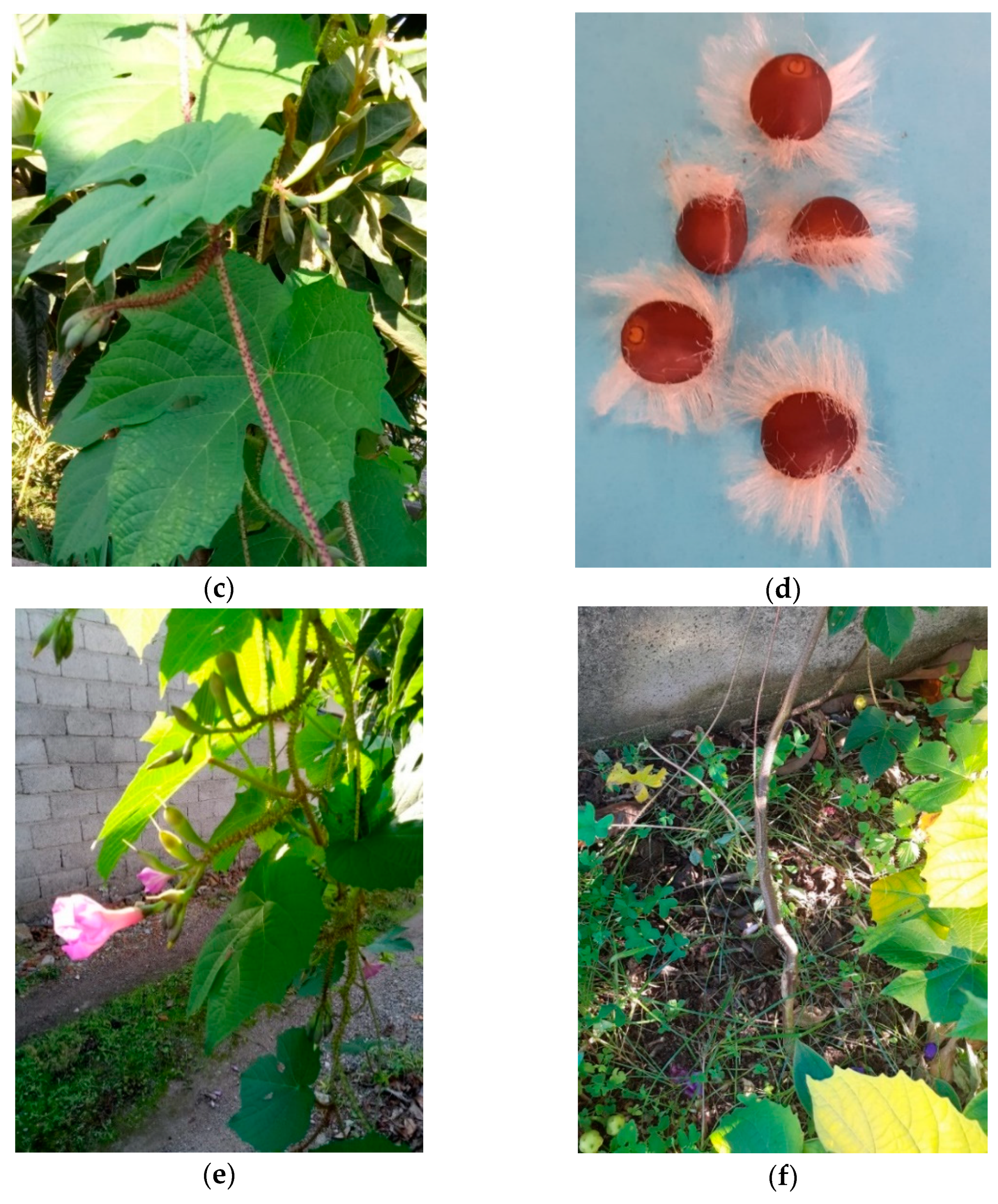
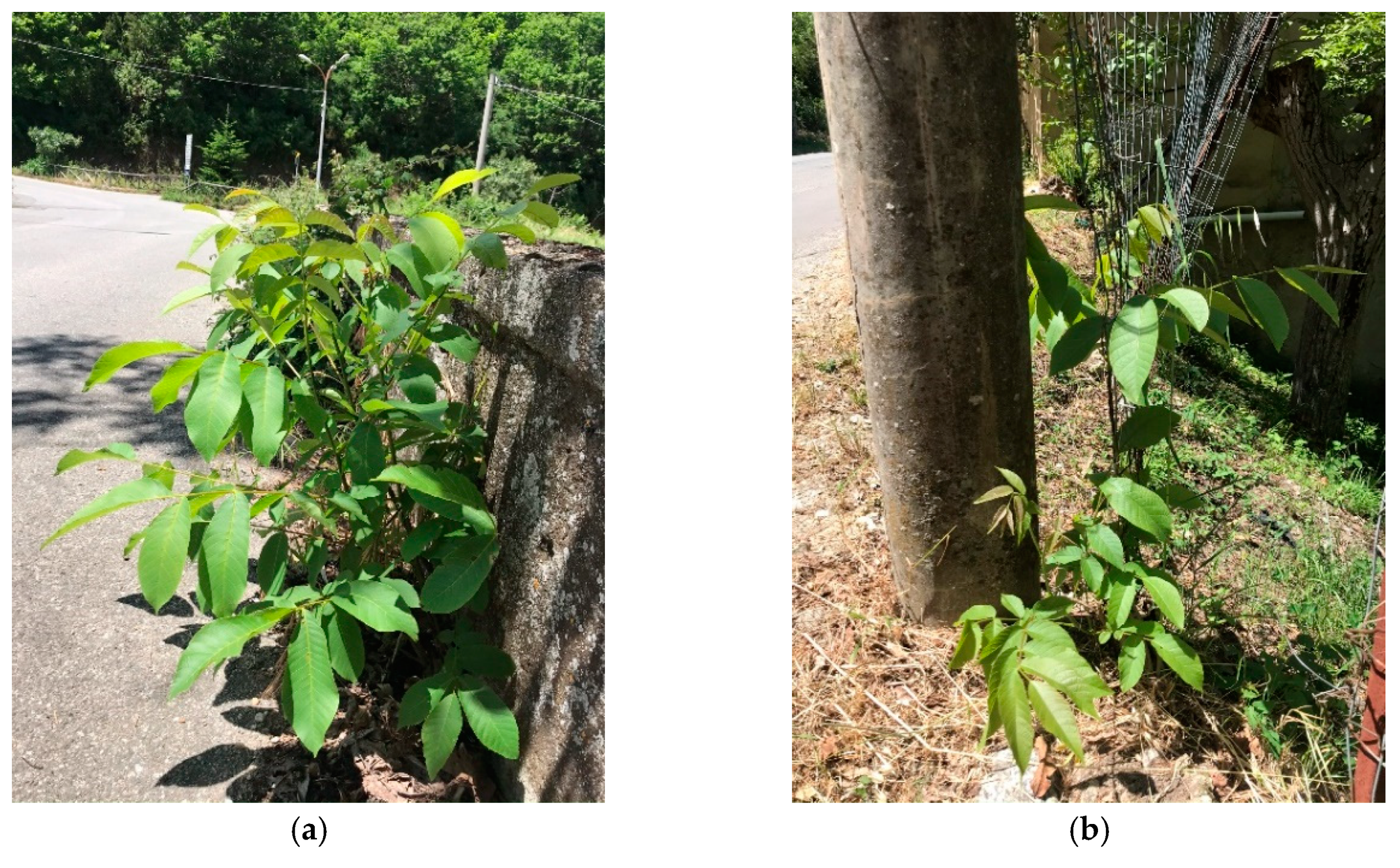
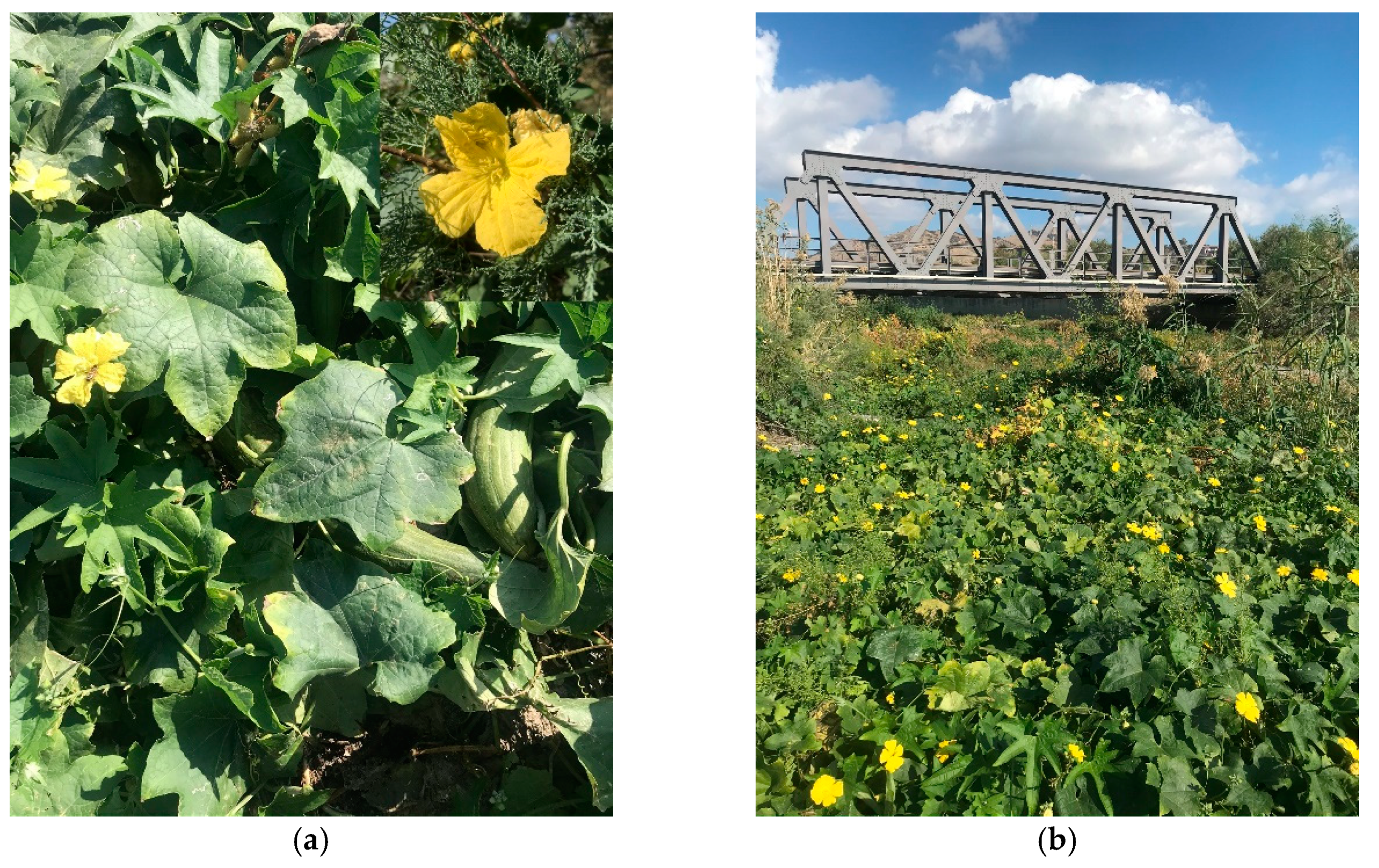
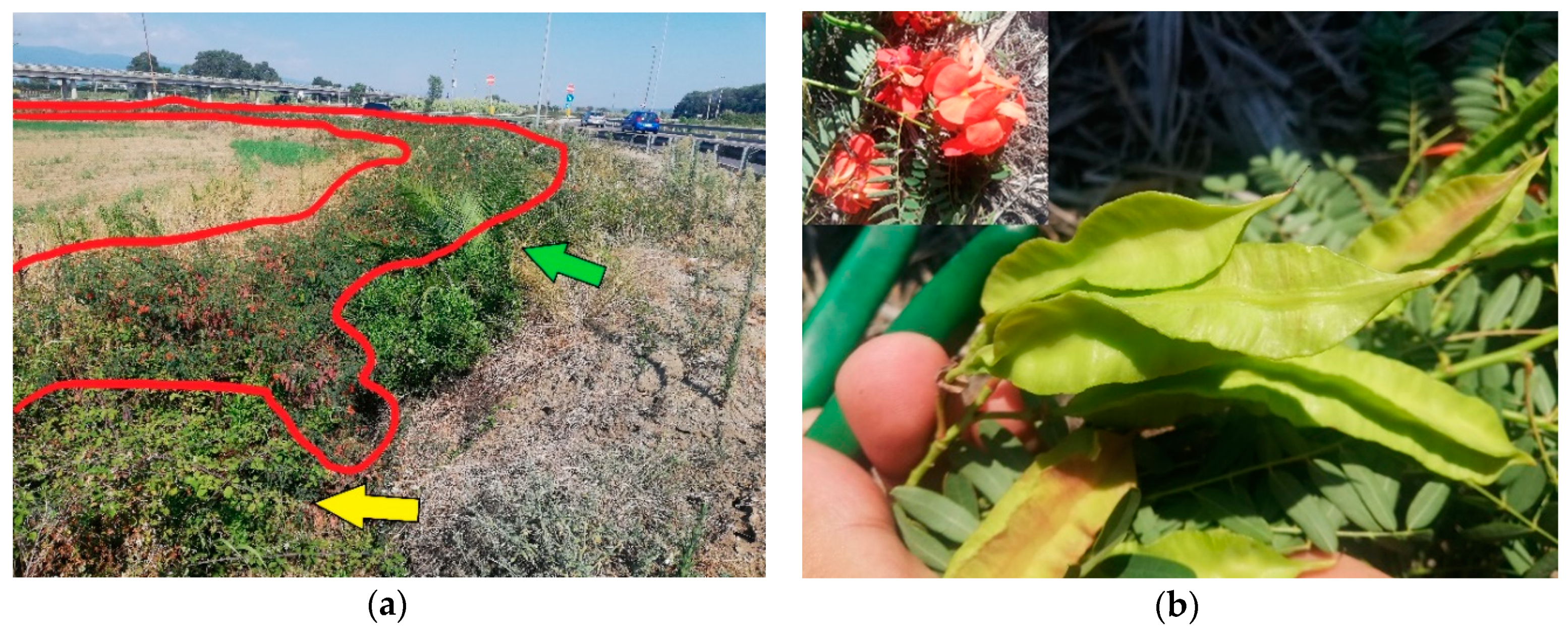


References
- Galasso, G.; Conti, F.; Peruzzi, L.; Ardenghi, N.M.G.; Banfi, E.; Celesti-Grapow, L.; Albano, A.; Alessandrini, A.; Bacchetta, G.; Ballelli, S.; et al. An updated checklist of the vascular flora alien to Italy. Plant Biosyst. 2018, 152, 556–592. [Google Scholar] [CrossRef]
- Cano Carmona, E.; Cano Ortiz, A.; Musarella, C.M. (Eds.) Introductory Chapter: Endemism as a Basic Element for the Conservation of Species and Habitats. In Endemic Species; IntechOpen: Rijeka, Croatia, 2019; pp. 1–7. [Google Scholar] [CrossRef]
- Cano-Ortiz, A.; Musarella, C.M.; Piñar, J.C.; Spampinato, G.; Veloz, A.; Cano, E. Vegetation of the dry bioclimatic areas in the Dominican Republic. Plant Biosyst. 2015, 149, 451–472. [Google Scholar] [CrossRef]
- Cano-Ortiz, A.; Musarella, C.M.; Piñar, J.C.; Pinto Gomes, C.J.; del Río González, S.; Cano, E. Diversity and conservation status of mangrove communities in two areas of Mesocaribea biogeographic region. Curr. Sci. 2018, 115, 534–540. [Google Scholar] [CrossRef]
- Pyšek, P.; Lambdon, P.W.; Arianoutsou, M.; Kühn, I.; Pino, J.; Winter, M. Alien vascular plants of Europe. In Handbook of Alien Species in Europe. Invading Nature; Springer Series in Invasion Ecology; Springer: Dordrecht, The Netherlands, 2009; Volume 3, pp. 43–61. [Google Scholar] [CrossRef]
- Verloove, F. Catalogue of neophytes in Belgium (1800–2005). Scr. Bot Belg. 2006, 39, 1–89. [Google Scholar]
- Nascimbene, J.; Nimis, P.L.; Benesperi, R. Mature non-native black-locust (Robinia pseudoacacia L.) forest does not regain the lichen diversity of the natural forest. Sci. Total Environ. 2012, 421–422, 197–202. [Google Scholar] [CrossRef]
- Nascimbene, J.; Lazzaro, L.; Benesperi, R. Patterns ofβ-diversity and similarity re-veal biotic homogenization of epiphytic lichen communities associated with thespread of black locust forests. Fungal Ecol. 2015, 14, 1–7. [Google Scholar] [CrossRef]
- Nascimbene, J.; Benesperi, R.; Casazza, G.; Chiarucci, A.; Giordani, P. Range shifts of native and invasive trees exacerbate the impact of climate change on epiphyte distribution: The case of lung lichen and black locust in Italy. Sci. Total Environ. 2020, 735, 139537. [Google Scholar] [CrossRef]
- Lazzaro, L.; Bolpagni, R.; Buffa, G.; Gentili, R.; Lonati, M.; Stinca, A.; Acosta, A.T.R.; Adorni, M.; Aleffi, M.; Allegrezza, M.; et al. Impact of invasive alien plants on native plant communities and Natura 2000 habitats: State of the art, gap analysis and perspectives in Italy. J. Environ. Manag. 2020, 274, 111140. [Google Scholar] [CrossRef]
- Tenore, M. Flora Napolitana 3; Stamperia Francese: Napoli, Italy, 1824. [Google Scholar]
- Tenore, M. Sylloge Plantarum Vascularium Florae Neapolitanae Hucusque Detectarum; Ex typographya Fibreni: Napoli, Italy, 1831; 556p. [Google Scholar]
- Gussone, G. Plantae Rariores Quas in Itinere per oras Jonii ac Adriatici Mais et per Regiones Samnii ac Aprutii; Ex Regia Tipografia Napoli: Napoli, Italy, 1826. [Google Scholar]
- Pasquale, G.A. Escursioni botaniche per la Calabria Ulteriore. Annali Acc. Aspiranti Natural. Napoli 1843, 1, 234–238. [Google Scholar]
- Porta, P. Viaggio intrapreso da Huter, Porta e Rigo in Calabria nel 1877. Nuovo Giorn. Bot. Ital. 1879, 11, 224–290. [Google Scholar]
- Musarella, C.M.; Tripodi, G. La flora della rupe e dei ruderi di Pentidattilo (Reggio Calabria). Inform. Bot. Ital. 2004, 36, 3–12. [Google Scholar]
- Crisafulli, A.; Maiorca, G.; Spampinato, G. Note floristiche per le Serre Calabre (Calabria centro-meridionale). Inform. Bot. Ital. 2006, 38, 363–372. [Google Scholar]
- Crisafulli, A.; Cannavò, S.; Maiorca, G.; Musarella, C.M.; Signorino, G.; Spampinato, G. Aggiornamenti floristici per la Calabria. Inform. Bot. Ital. 2010, 42, 431–442. [Google Scholar]
- Bernardo, L.; Peruzzi, L.; Passalacqua, N.G. Flora Vascolare della Calabria. Prodromo. Volume, I. Inform. Bot. Ital. 2011, 43, 185–332. [Google Scholar]
- Bernardo, L.; Bartolucci, F.; Cancellieri, L.; Costalonga, S.; Galasso, G.; Galesi, R.; Gargano, D.; Iberite, M.; Iocchi, M.; Lattanzi, E.; et al. Contributo alla conoscenza floristica della Calabria: Resoconto dell’escursione del Gruppo di Floristica (S.B.I.) nel 2008 nella Presila Catanzarese. Inform. Bot. Ital. 2012, 44, 125–151. [Google Scholar]
- Signorino, G.; Cannavò, S.; Crisafulli, A.; Musarella, C.M.; Spampinato, G. Fagonia cretica L. Inf. Bot. Ital. 2011, 43, 397–399. [Google Scholar]
- Spampinato, G. Guida alla Flora dell’Aspromonte; Laruffa: Reggio Calabria, Italy, 2014. [Google Scholar]
- Brullo, S.; Scelsi, F.; Spampinato, G. La Vegetazione dell’Aspromonte; Laruffa Editore: Reggio Calabria, Italy, 2001. [Google Scholar]
- Maiorca, G.; Spampinato, G.; Caprio, A. Flora e vegetazione dei laghi costieri La Vota (Calabria centro-occidentale). Fitosociologia 2002, 39, 81–108. [Google Scholar]
- Puglisi, M. Lineamenti della vegetazione briofitica dell’Aspromonte (Italia meridionale). Inform. Bot. Ital. 2006, 38 (Suppl. 1), 160–162. [Google Scholar]
- Spampinato, G.; Sciandrello, S.; del Galdo, G.; Puglisi, M.; Tomaselli, V.; Cannavò, S.; Musarella, C.M. Contribution to the knowledge of Mediterranean wetland biodiversity: Plant communities of the Aquila Lake (Calabria, Southern Italy). Plant Sociol. 2019, 56, 53–68. [Google Scholar] [CrossRef]
- Viciani, D.; Vidali, M.; Gigante, D.; Bolpagni, R.; Villani, M.; Acosta, A.T.R.; Adorni, M.; Aleffi, M.; Allegrezza, M.; Angiolini, C.; et al. A first checklist of the alien-dominated vegetation in Italy. Plant Sociol. 2020, 57, 29–54. [Google Scholar] [CrossRef]
- Maiorca, G.; Crisafulli, A.; Puntillo, D.; Signorino, G.; Spampinato, G. Wetland vegetation of the Tarsia Lake Regional Nature Reserve (Calabria, southern Italy). Medit. Bot. 2020, 41, 67–84. [Google Scholar] [CrossRef]
- Kunkar, A.; Kunkar, E. Le Piante Officinali in Calabria e loro Possibile Utilizzo; Laruffa: Reggio Calabria, Italy, 2000. [Google Scholar]
- Passalacqua, N.G.; De Fine, G.; Guarrera, P.M. Contribution to the knowledge of the veterinary science and of the ethnobotany in Calabria region (Southern Italy). J. Ethnobiol. Ethnomed. 2006, 2, 52. [Google Scholar] [CrossRef] [PubMed]
- Passalacqua, N.G.; Guarrera, P.M.; De Fine, G. Contribution to the knowledge of the folk plant medicine in Calabria region (Southern Italy). Fitoterapia 2007, 78, 52–68. [Google Scholar] [CrossRef] [PubMed]
- Leporatti, M.L.; Impieri, M. Ethnobotanical note about some uses of medicinal plants in Alto Tirreno Cosentino area (Calabria, Southern Italy). J. Ethnobiol. Ethnomed. 2007, 3, 34. [Google Scholar] [CrossRef]
- Maruca, G.; Spampinato, G.; Turiano, D.; Laghetti, G.; Musarella, C.M. Ethnobotanical notes about medicinal and useful plants of the Reventino Massif tradition (Calabria region, Southern Italy). Gen. Resour. Crop. Evol. 2019, 66, 1027–1040. [Google Scholar] [CrossRef]
- Mattalia, G.; Sõukand, R.; Corvo, P.; Pieroni, A. Blended divergences: Local food and medicinal plant uses among Arbëreshë, Occitans, and autochthonous Calabrians living in Calabria, Southern Italy. Plant Biosyst. 2020, 154, 615–626. [Google Scholar] [CrossRef]
- Musarella, C.M.; Paglianiti, I.; Cano-Ortiz, A.; Spampinato, G. Ethnobotanical study in the Poro and Preserre Calabresi territory (Vibo Valentia, S-Italy). Atti Soc. Toscana Sci. Nat. Mem. Ser. B 2019, 126, 13–28. [Google Scholar] [CrossRef]
- Cano, E.; Musarella, C.M.; Cano-Ortiz, A.; Piñar Fuentes, J.C.; Spampinato, G.; Pinto Gomes, C.J. Morphometric analysis and bioclimatic distribution of Glebionis coronaria s.l. (Asteraceae) in the Mediterranean area. PhytoKeys 2017, 81, 103–126. [Google Scholar] [CrossRef]
- Musarella, C.M.; Cano-Ortiz, A.; Piñar Fuentes, J.C.; Navas-Ureña, J.; Pinto Gomes, C.J.; Quinto-Canas, R.; Cano, E.; Spampinato, G. Similarity analysis between species of the genus Quercus L. (Fagaceae) in southern Italy based on the fractal dimension. PhytoKeys 2018, 113, 79–95. [Google Scholar] [CrossRef]
- Panuccio, M.R.; Fazio, A.; Musarella, C.M.; Mendoza-Fernández, A.J.; Mota, J.F.; Spampinato, G. Seed germination and antioxidant pattern in Lavandula multifida (Lamiaceae): A comparison between core and peripheral populations. Plant Biosyst. 2018, 152, 398–406. [Google Scholar] [CrossRef]
- Tundis, R.; Loizzo, M.R.; Bonesi, M.; Leporini, M.; Menichini, F.; Passalacqua, N.G. A study of Salvia fruticosa Mill subsp. thomasii (Lacaita) Brullo, Guglielmo, Pavone & Terrasi, an endemic Sage of Southern Italy. Plant Biosyst. 2018, 152, 130–141. [Google Scholar] [CrossRef]
- Spampinato, G.; Crisarà, R.; Cannavò, S.; Musarella, C.M. Phytotoponims of southern Calabria: A tool for the analysis of the landscape and its transformations. Atti Soc. Toscana Sci. Nat. Mem. Ser. B 2017, 124, 61–72. [Google Scholar] [CrossRef]
- Spampinato, G.; Musarella, C.M.; Cano-Ortiz, A.; Signorino, G. Habitat, occurrence and conservation status of the Saharo-Macaronesian and Southern-Mediterranean element Fagonia cretica L. (Zygophyllaceae) in Italy. J. Arid Land 2018, 10, 140–151. [Google Scholar] [CrossRef]
- Spampinato, G.; Massimo, D.E.; Musarella, C.M.; De Paola, P.; Malerba, A.; Musolino, M. Carbon Sequestration by Cork Oak Forests and Raw Material to Built up Post Carbon City. In New Metropolitan Perspectives; Calabrò, F., Della Spina, L., Bevilacqua, C., Eds.; ISHT 2018. 2019b. Smart Innovation, Systems and Technologies; Springer: Cham, Switzerland, 2018; Volume 101. [Google Scholar]
- Bartolucci, F.; Peruzzi, L.; Galasso, G.; Albano, A.; Alessandrini, A.; Ardenghi, N.M.G.; Astuti, G.; Bacchetta, G.; Ballelli, S.; Banfi, E.; et al. An updated checklist of the vascular flora native to Italy. Plant Biosyst. 2018, 152, 179–303. [Google Scholar] [CrossRef]
- Musarella, C.M.; Stinca, A.; Cano-Ortíz, A.; Laface, V.L.A.; Petrilli, R.; Esposito, A.; Spampinato, G. New data on the alien vascular flora of Calabria (southern Italy). Ann. Bot. 2020, 10, 55–66. [Google Scholar] [CrossRef]
- Galasso, G.; Domina, G.; Adorni, M.; Ardenghi, N.M.G.; Bonari, G.; Buono, S.; Cancellieri, L.; Chianese, G.; Ferretti, G.; Fiaschi, T.; et al. Notulae to the Italian alien vascular flora: 5. Ital. Bot. 2018, 5, 45–56. [Google Scholar] [CrossRef][Green Version]
- Galasso, G.; Domina, G.; Alessandrini, A.; Ardenghi, N.M.G.; Bacchetta, G.; Ballelli, S.; Bartolucci, F.; Brundu, G.; Buono, S.; Busnardo, G.; et al. Notulae to the Italian alien vascular flora: 6. Ital. Bot. 2018, 6, 65–90. [Google Scholar] [CrossRef]
- Galasso, G.; Domina, G.; Ardenghi, N.M.G.; Aristarchi, C.; Bacchetta, G.; Bartolucci, F.; Bonari, G.; Bouvet, D.; Brundu, G.; Buono, S.; et al. Notulae to the Italian alien vascular flora: 7. Ital. Bot. 2019, 7, 157–182. [Google Scholar] [CrossRef]
- Galasso, G.; Domina, G.; Andreatta, S.; Angiolini, C.; Ardenghi, N.M.G.; Aristarchi, C.; Arnoul, M.; Azzella, M.M.; Bacchetta, G.; Bartolucci, F.; et al. Notulae to the Italian alien vascular flora: 8. Ital. Bot. 2019, 8, 63–93. [Google Scholar] [CrossRef]
- Musarella, C.M.; Laface, V.L.A.; Morabito, A.; Cano-Ortiz, A.; Cannavò, S.; Spampinato, G. Aggiornamenti sulla flora alloctona calabrese: Novità e conferme. Notiz. Soc. Bot. Ital. 2019, 3, 39–40. [Google Scholar]
- Spampinato, G.; Cannavò, S.; Cano-Ortiz, A.; Caruso, G.; Laface, V.L.A.; Noto, D.; Quinto-Canas, R.; Musarella, C.M. Invasività di Cenchrus setaceus (Forssk.) Morrone in Italia. Notiz. Soc. Bot. Ital. 2019, 3, 1–10. [Google Scholar]
- Musarella, C.M. Solanum torvum Sw. (Solanaceae): A new alien species for Europe. Gen. Resour. Crop Evolut. 2020, 67, 515–522. [Google Scholar] [CrossRef]
- Rosati, L.; Fascetti, S.; Romano, V.A.; Potenza, G.; Lapenna, M.R.; Capano, A.; Nicoletti, P.; Farris, E.; de Lange, P.J.; Del Vico, E.; et al. New Chorological Data for the Italian Vascular Flora. Diversity 2020, 12, 22. [Google Scholar] [CrossRef]
- Posillipo, G. La Flora Aliena: Stato delle Conoscenze in Calabria. Bachelor’s Thesis, Mediterraean University of Reggio Calabria, Reggio Calabria, Italy, 30 March 2020. [Google Scholar]
- Galasso, G.; Domina, G.; Adorni, M.; Angiolini, C.; Apruzzese, M.; Ardenghi, N.M.G.; Assini, S.; Aversa, M.; Bacchetta, G.; Banfi, E.; et al. Notulae to the Italian alien vascular flora: 9. Ital. Bot. 2020, 9, 47–70. [Google Scholar] [CrossRef]
- Ziska, L.H.; Dukes, J.S. Invasive Species and Global Climate Change; CABI Publishing: Wallingford, UK, 2014; p. 368. ISBN 9781780641645. [Google Scholar] [CrossRef]
- Guézou, A.; Trueman, M.; Buddenhagen, C.E.; Chamorro, S.; Guerrero, A.M.; Pozo, P.; Atkinson, R. An Extensive Alien Plant Inventory from the Inhabited Areas of Galapagos. PLoS ONE 2010, 5, e10276. [Google Scholar] [CrossRef]
- Andrabi, S.M.; Reshi, Z.A.; Shah, M.A.; Qureshi, S. Studying the patterns of alien and native floras of some habitats in Srinagar city, Kashmir, India. Ecol. Process. 2015, 4, 493. [Google Scholar] [CrossRef]
- Muzafar, I.; Khuroo, A.A.; Mehraj, G.; Hamid, M.; Rashid, I.; Malik, A.H. Floristic diversity along the roadsides of an urban biodiversity hotspot in Indian Himalayas. Plant Biosyst. 2019, 153, 222–230. [Google Scholar] [CrossRef]
- Hansen, M.J.; Clevenger, A.P. The influence of disturbance and habitat on the presence of non-native plant species along transport corridors. Biol. Conserv. 2005, 125, 249–259. [Google Scholar] [CrossRef]
- Council Directive 92/43/EEC of 21 May 1992 on the Conservation of Natural Habitats and of Wild Fauna and Flora. Available online: https://eur-lex.europa.eu/legal-content/EN/TXT/?uri=CELEX%3A31992L0043 (accessed on 18 August 2020).
- Directive 2009/147/EC of the European Parliament and of the Council of 30 November 2009 on the Conservation of Wild Birds. Available online: https://eur-lex.europa.eu/eli/dir/2009/147/oj (accessed on 18 August 2020).
- Lazzaro, L.; Bolpagni, R.; Barni, E.; Brundu, G.; Blasi, C.; Siniscalco, C.; Celesti-Grapow, L. Towards alien plant prioritization in Italy: Methodological issues and first results. Plant Biosyst. 2019, 153, 740–746. [Google Scholar] [CrossRef]
- Lazzaro, L.; Bolpagni, R.; Acosta, A.T.R.; Adorni, M.; Aleffi, M.; Allegrezza, M.; Angiolini, C.; Assini, S.; Bagella, S.; Bonari, G.; et al. An Assessment of the Impacts of Invasive Alien Plants on Habitats in Italy: First Results from the Ispra-Sisv Convention. In Proceedings of the NEOBIOTA 2018 10th International Conference on Biological Invasions, New Directions in Invasion Biology, Dublin, Ireland, 4–7 September 2018; p. 84. [Google Scholar]
- Castellano, G.; Marino, P. Segnalazione di Pennisetum setaceum (Poaceae) in Calabria. In Proceedings of the 102° Congresso della Società Botanica Italiana, Palermo, Italy, 26–29 September 2007; Venturella, G., Raimondo, F.M., Eds.; p. 295. [Google Scholar]
- Brundu, G. Information on Measures and Related Costs in Relation to Species Included on the Union List: Pennisetum setaceum; Technical Note for IUCN for the European Commission. Available online: https://circabc.europa.eu/sd/a/2f7ce5bd-07c4-49af-8506-7ed0917b6ad7/TSSR-2016-003%20Pennisetum%20setaceum.pdf (accessed on 18 June 2020).
- Kington, S. The International Daffodil Register and Classified List 2008; Royal Horticultural Society: London, UK, 2008. [Google Scholar]
- Thiers, B. Index Herbariorum: A Global Directory of Public Herbaria and Associated Staff. New York Botanical Garden’s Virtual Herbarium. 2019. Available online: http://sweetgum.nybg.org/science/ih/ (accessed on 13 May 2020).
- Tutin, T.G. Flora Europaea, 2nd ed.; Cambridge University Press: Cambridge, UK, 1993; ISBN 978-0-521-41007-6. [Google Scholar]
- Tutin, T.G. Flora Europaea: Rosaceae to Umbelliferae. In Flora Europaea; Cambridge University Press: Cambridge, UK, 2001; ISBN 978-0-521-06662-4. [Google Scholar]
- Tutin, T.G. Flora Europaea: Diapensiaceae to Myoporaceae; Cambridge University Press: Cambridge, UK, 2007; ISBN 978-0-521-08489-5. [Google Scholar]
- Tutin, T.G. Flora Europaea: Plantaginaceae to Compositae (and Rubiaceae); Cambridge University Press: Cambridge, UK, 2006; ISBN 978-0-521-08717-9. [Google Scholar]
- Tutin, T.G. Flora Europaea: Alismataceae to Orchidaceae (Monocotyledones); Paperback Printing; Cambridge University Press: Cambridge, UK, 2010; ISBN 978-0-521-20108-7. [Google Scholar]
- Pignatti, S. Flora d’Italia; 1–3; Edagricole: Bologna, Italy, 1982. [Google Scholar]
- Pignatti, S. Flora d’Italia: In 4 Volumi. Volume 1: Flora d’Italia & Flora Digitale, 2nd ed.; Edagricole-Edizioni Agricole di New Business Media srl: Milano, Italy, 2017; ISBN 978-88-506-5242-6. [Google Scholar]
- Pignatti, S. Flora d’Italia: In 4 Volumi. Volume 2: Flora d’Italia & Flora Digitale, 2nd ed.; Edagricole-Edizioni Agricole di New Business Media srl: Milano, Italy, 2017; ISBN 978-88-506-5243-3. [Google Scholar]
- Pignatti, S. Flora d’Italia: In 4 Volumi. Volume 3: Flora d’Italia & Flora Digitale, 2nd ed.; Edagricole-Edizioni Agricole di New Business Media srl: Milano, Italy, 2018; ISBN 978-88-506-5244-0. [Google Scholar]
- Pignatti, S.; Guarino, R.; La Rosa, M. Flora d’Italia: In 4 Volumi Volume 4: Flora d’Italia & Flora Digitale, 2nd ed.; Edagricole-Edizioni Agricole di New Business Media srl: Milano, Italy, 2019; ISBN 978-88-506-5245-7. [Google Scholar]
- Flora of North America. Available online: http://www.efloras.org/flora_page.aspx?flora_id=1 (accessed on 30 May 2020).
- Flora of China. Available online: http://www.efloras.org/flora_page.aspx?flora_id=2 (accessed on 4 April 2020).
- Wang, L. Freesia. Flower Breeding and Genetics; Anderson, N.O., Ed.; Springer: Dordrecht, The Netherlands, 2007. [Google Scholar] [CrossRef]
- Wood, J.R.I.; Munoz-Rodriguez, P.; Williams, B.R.M.; Scotland, R.W. A foundation monograph of Ipomoea (Convolvulaceae) in the New World. PhytoKeys 2020, 143, 1–823. [Google Scholar] [CrossRef]
- Hanks, G.R. Narcissus and Daffodil: The Genus Narcissus; Taylor & Francis Ltd.: London, UK, 2002. [Google Scholar]
- Euro+Med (2006–2020): Euro+Med PlantBase-The Information Resource for Euro-Mediterranean Plant Diversity. Available online: http://ww2.bgbm.org/EuroPlusMed/ (accessed on 10 July 2020).
- Flora of Cyprus—A Dynamic Checklist. Available online: http://www.flora-of-cyprus.eu/ (accessed on 10 July 2020).
- Portale della Flora d’Italia/Portal to the Flora of Italy. Available online: http:/dryades.units.it/floritaly (accessed on 17 August 2020).
- Pyšek, P.; Richardson, D.M.; Rejmánek, M.; Webster, G.L.; Williamson, M.; Kirschner, J. Alien plants in checklists and floras: Towards better communication between taxonomists and ecologists. Taxon 2004, 53, 131–143. [Google Scholar] [CrossRef]
- Grapow, L.C.; Grapow, L.C.; Alessandrini, A.; Arrigoni, P.V.; Banfi, E.; Bernardo, L.; Bovio, M.; Brundu, G.; Camarda, I.; Carli, E.; et al. The inventory of the non-native flora of Italy. Plant Biosyst. 2009, 143, 386–430. [Google Scholar] [CrossRef]
- European Commission. Regulation (EU) No 1143/2014 of the European Parliament and of the Council of 22 October 2014 on the Prevention and Management of the Introduction and Spread of Invasive Alien Species. Off. J. Eur. Union. 2014, 317, 35–55. [Google Scholar]
- Riera, V.J. Colección de Plantas Vasculares del Herbario de la Universitat de València (VAL). Botanical Garden, University of Valencia. 2020, Occurrence Dataset. Available online: https://www.gbif.org/occurrence/2558255855 (accessed on 24 March 2020).
- Alvarado-Cárdenas, L.O.; Villaseñor, J.L.; López-Mata, L.; Cadena, J.C.; Ortiz, E. Systematics, distribution and conservation of Cascabela (Apocynaceae: Rauvolfioideae: Plumerieae) in Mexico. Plant. Syst. Evol. 2017, 303, 337–369. [Google Scholar] [CrossRef]
- DAISIE-Inventory of Alien Invasive Species in Europe. Version 1.6. Research Institute for Nature and Forest (INBO). Checklist Dataset. Available online: https://doi.org/10.15468/ybwd3x (accessed on 17 April 2020).
- Leandro Brotto, M. MBM-Herbário do Museu Botânico Municipal. Version 1.63. Museu Botânico Municipal. 2020. Occurrence Dataset. Available online: https://www.gbif.org/occurrence/1095425468 (accessed on 17 April 2020).
- Popay, I. Passiflora caerulea L. In Invasive Species Compendium; CAB International: Wallingford, UK, 2020; Available online: https://www.cabi.org/isc/datasheet/116172 (accessed on 17 April 2020).
- Stinca, A.; Chianese, G.; D’Auria, G.; Del Guacchio, E.; Fascetti, S.; Perrino, E.V.; Rosati, L.; Salerno, G.; Santangelo, A. New alien vascular species for the flora of southern Italy. Webbia 2017, 72, 295–301. [Google Scholar] [CrossRef]
- Lusweti, A. Tecoma stans. Available online: https://keys.lucidcentral.org/keys/v3/eafrinet/weeds/key/weeds/Media/Html/Tecoma_stans_(Yellow_Bells) (accessed on 17 June 2020).
- Tecoma stans. Available online: https://www.cabi.org/isc/datasheet/52951 (accessed on 17 June 2020).
- Creuwels, J. Naturalis Biodiversity Center (NL)-Botany. Naturalis Biodiversity Center. Occurrence Dataset. Available online: https://www.gbif.org/occurrence/2516615499 (accessed on 24 April 2020). [CrossRef]
- Stinca, A.; D’Auria, G.; Motti, R. Integrazioni alla flora vascolare aliena della Campania (Sud Italia). Inf. Bot. Ital. 2012, 44, 287–293. [Google Scholar]
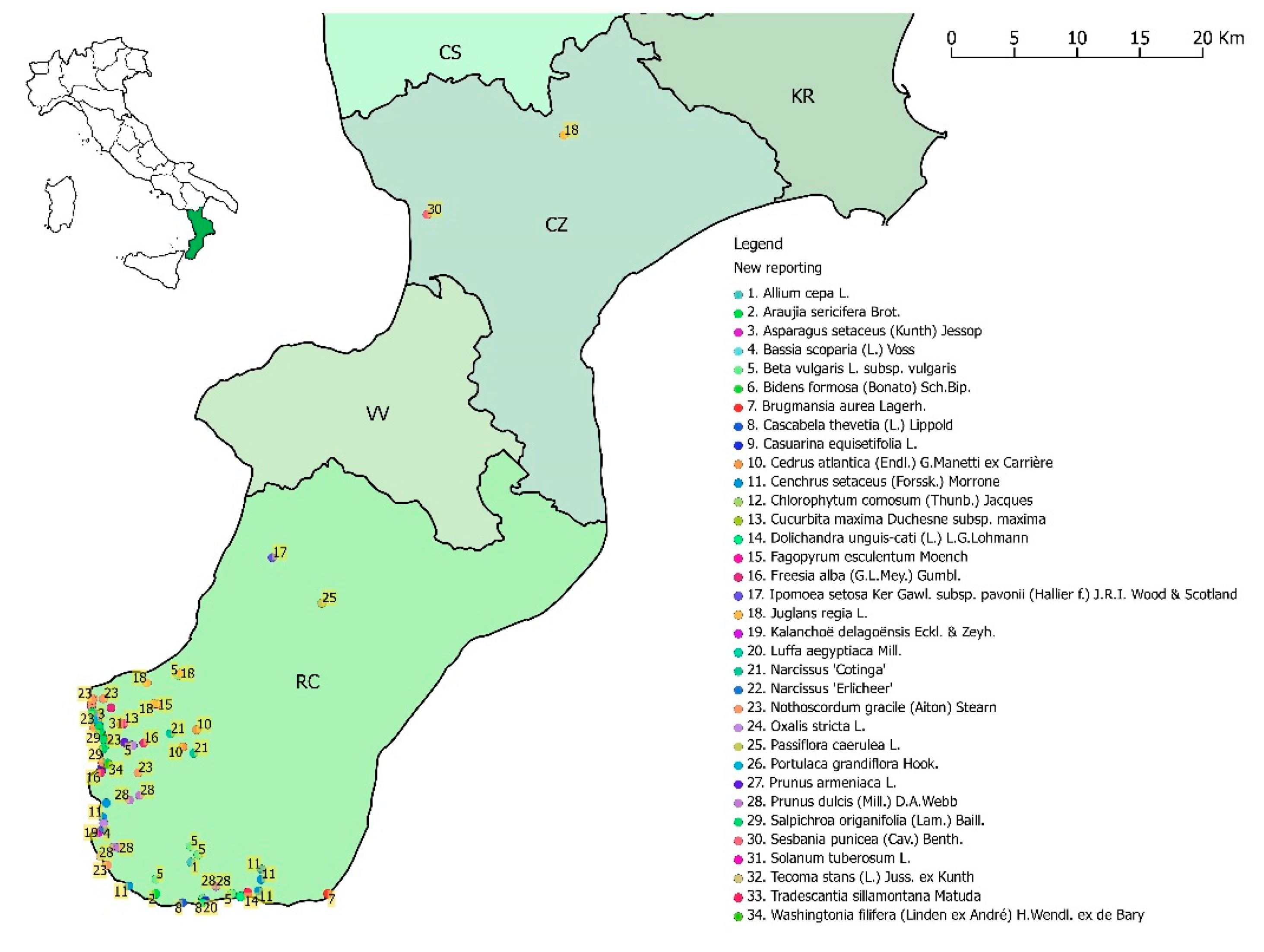

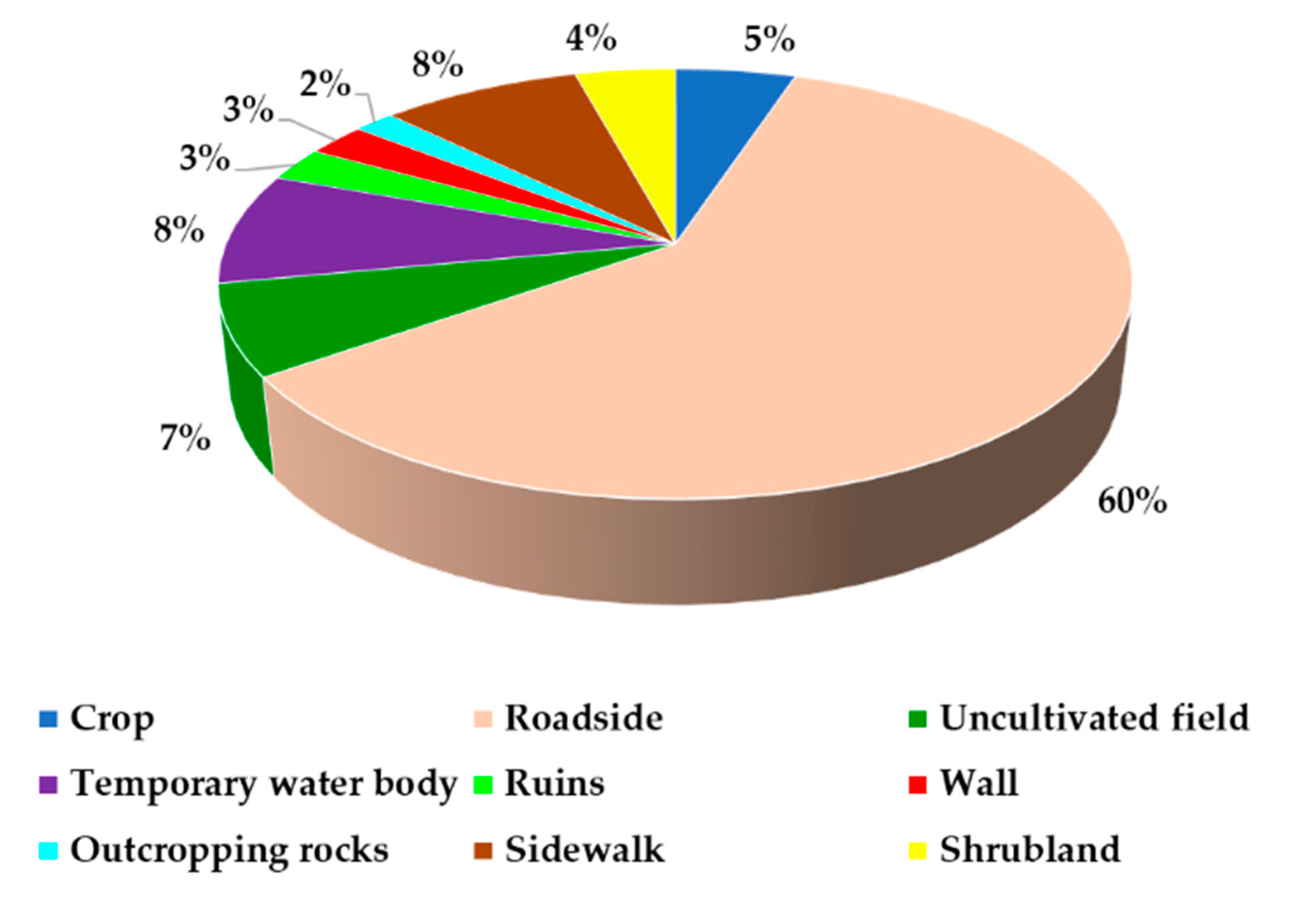
| ID | Taxon | First Record for Europe | First Record for Italy | First Record for Calabria | Confirmation for Calabria | Current Status | Previous Status |
|---|---|---|---|---|---|---|---|
| 1 | Allium cepa L. | X | C | ||||
| 2 | Araujia sericifera Brot. | G | C | ||||
| 3 | Asparagus setaceus (Kunth) Jessop | X | C | ||||
| 4 | Bassia scoparia (L.) Voss | X | C | ||||
| 5 | Beta vulgaris L. subsp. vulgaris | X | N | ||||
| 6 | Bidens formosa (Bonato) Sch. Bip. | X | C | ||||
| 7 | Brugmansia aurea Lagerh. | X | C | ||||
| 8 | Cascabela thevetia (L.) Lippold | X | C | ||||
| 9 | Casuarina equisetifolia L. | X | C | ||||
| 10 | Cedrus atlantica (Endl.) G. Manetti ex Carrière | X | C | ||||
| 11 | Cenchrus setaceus (Forssk.) Morrone | I | N | ||||
| 12 | Chlorophytum comosum (Thunb.) Jacques | X | C | ||||
| 13 | Cucurbita maxima Duchesne subsp. maxima | X | C | ||||
| 14 | Dolichandra unguis-cati (L.) L.G. Lohmann | X | C | ||||
| 15 | Fagopyrum esculentum Moench | X | C | ||||
| 16 | Freesia alba (G.L. Mey.) Gumbl. | X | C | ||||
| 17 | Ipomoea setosa Ker Gawl. subsp. pavonii (Hallier f.) J.R.I. Wood & Scotland | X | C | ||||
| 18 | Juglans regia L. | X | C | ||||
| 19 | Kalanchoë delagoënsis Eckl. & Zeyh. | X | C | ||||
| 20 | Luffa aegyptiaca Mill. | IP | X | C | |||
| 21 | Narcissus ‘Cotinga’ | X | N | ||||
| 22 | Narcissus ‘Erlicheer’ | X | C | ||||
| 23 | Nothoscordum gracile (Aiton) Stearn | I | C | ||||
| 24 | Oxalis stricta L. | X | C | ||||
| 25 | Passiflora caerulea L. | X | C | ||||
| 26 | Portulaca grandiflora Hook. | X | C | ||||
| 27 | Prunus armeniaca L. | X | C | ||||
| 28 | Prunus dulcis (Mill.) D.A. Webb | X | C | ||||
| 29 | Salpichroa origanifolia (Lam.) Baill. | I | N | ||||
| 30 | Sesbania punicea (Cav.) Benth. | I | N | ||||
| 31 | Solanum tuberosum L. | X | C | ||||
| 32 | Tecoma stans (L.) Juss. ex Kunth | X | C | ||||
| 33 | Tradescantia sillamontana Matuda | X | C | ||||
| 34 | Washingtonia filifera (Linden ex André) H. Wendl. ex de Bary | X | C |
| ID | Taxon | Family | Period of Introduction | Native Range | Life Form | Habitat | No. of Records |
|---|---|---|---|---|---|---|---|
| 1 | Allium cepa L. | Amaryllidaceae | Archeophyte | Culton | G bulb | Crop | 1 |
| 2 | Araujia sericifera Brot. | Apocynaceae | Neophyte | Southern America | P lian | Roadside | 2 |
| 3 | Asparagus setaceus (Kunth) Jessop | Asparagaceae | Neophyte | Southern Africa | P lian | Uncultivated field | 5 |
| 4 | Bassia scoparia (L.) Voss | Chenopodiaceae | Neophyte | Central Asia | T scap | Roadside | 1 |
| 5 | Beta vulgaris L. subsp. vulgaris | Chenopodiaceae | Archeophyte | Culton | H scap | Crop/Uncultivated field/Roadside | 7 |
| 6 | Bidens formosa (Bonato) Sch. Bip. | Asteraceae | Neophyte | Northern and Central America | T scap | Roadside | 2 |
| 7 | Brugmansia aurea Lagerh. | Solanaceae | Neophyte | Ecuador | NP | Roadside | 1 |
| 8 | Cascabela thevetia (L.) Lippold | Apocynaceae | Neophyte | Central and Southern America | Ch frut | Temporary water body | 2 |
| 9 | Casuarina equisetifolia L. | Casuarinaceae | Neophyte | Australia | P scap | Wall | 2 |
| 10 | Cedrus atlantica (Endl.) G. Manetti ex Carrière | Pinaceae | Neophyte | Northern Africa | P scap | Shrubland | 2 |
| 11 | Cenchrus setaceus (Forssk.) Morrone | Poaceae | Neophyte | Northern and Eastern Africa and Arabian Peninsula | H caesp | Roadside | 6 |
| 12 | Chlorophytum comosum (Thunb.) Jacques | Asparagaceae | Neophyte | Southern Africa | H scap | Temporary water body | 2 |
| 13 | Cucurbita maxima Duchesne subsp. maxima | Cucurbitaceae | Neophyte | Culton | T scap | Temporary water body/Roadside | 2 |
| 14 | Dolichandra unguis-cati (L.) L.G. Lohmann | Bignoniaceae | Neophyte | Southern America | P lian | Temporary water body/Ruins | 3 |
| 15 | Fagopyrum esculentum Moench | Polygonaceae | Neophyte | Asia | T scap | Roadside | 1 |
| 16 | Freesia alba (G.L. Mey.) Gumbl. | Iridaceae | Neophyte | Southern Africa | G bulb | Roadside/Ruins/Wall | 3 |
| 17 | Ipomoea setosa Ker Gawl. subsp. pavonii (Hallier f.) J.R.I. Wood & Scotland | Convolvulaceae | Neophyte | Southern America | G bulb | Roadside | 1 |
| 18 | Juglans regia L. | Juglandaceae | Cryptogenic | Western Asia | P scap | Temporary water body/Roadside | 5 |
| 19 | Kalanchoë delagoënsis Eckl. & Zeyh. | Crassulaceae | Neophyte | Southern Africa | Ch succ | Roadside | 1 |
| 20 | Luffa aegyptiaca Mill. | Cucurbitaceae | Neophyte | Southern Africa | T scap | Temporary water body | 1 |
| 21 | Narcissus ‘Cotinga’ | Amaryllidaceae | Neophyte | Culton | G bulb | Crop/Shrubland | 2 |
| 22 | Narcissus ‘Erlicheer’ | Amaryllidaceae | Neophyte | Culton | G bulb | Roadside | 1 |
| 23 | Nothoscordum gracile (Aiton) Stearn | Amaryllidaceae | Neophyte | Southern America | G bulb | Roadside/Sidewalk | 36 |
| 24 | Oxalis stricta L. | Oxalidaceae | Neophyte | Northern America | H scap | Sidewalk | 3 |
| 25 | Passiflora caerulea L. | Passifloraceae | Neophyte | Southern America | P lian | Roadside | 1 |
| 26 | Portulaca grandiflora Hook. | Portulacaceae | Neophyte | Southern America | T scap | Roadside/Sidewalk | 2 |
| 27 | Prunus armeniaca L. | Rosaceae | Archeophyte | Culton | P scap | Crop | 1 |
| 28 | Prunus dulcis (Mill.) D.A. Webb | Rosaceae | Archeophyte | Feral | P scap | Outcropping rocks/Roadside/Shrubland | 7 |
| 29 | Salpichroa origanifolia (Lam.) Baill. | Solanaceae | Neophyte | Southern America | Ch frut | Roadside | 10 |
| 30 | Sesbania punicea (Cav.) Benth. | Fabaceae | Neophyte | Southern America | P scap | Temporary water body | 1 |
| 31 | Solanum tuberosum L. | Solanaceae | Neophyte | Culton | T scap | Temporary water body | 1 |
| 32 | Tecoma stans (L.) Juss. ex Kunth | Bignoniaceae | Neophyte | Northern America | P lian | Sidewalk | 1 |
| 33 | Tradescantia sillamontana Matuda | Commelinaceae | Neophyte | Southern America | G rhiz | Uncultivated field | 1 |
| 34 | Washingtonia filifera (Linden ex André) H. Wendl. ex de Bary | Arecaceae | Neophyte | Northern America | P scap | Sidewalk | 1 |
| Total | 118 |
| ID | Taxon | SAC/SPA | SAC/SPA Code | SAC/SPA Name |
|---|---|---|---|---|
| 5 | Beta vulgaris L. subsp. vulgaris | SAC | IT9350145 | Fiumara Amendolea (incluso Roghudi, Chorio e Rota Greco) |
| 5 | Beta vulgaris L. subsp. vulgaris | SPA | IT9350300 | Costa Viola |
| 10 | Cedrus atlantica (Endl.) G.Manetti ex Carrière | SPA | IT9350300 | Costa Viola |
| 15 | Fagopyrum esculentum Moench | SPA | IT9350300 | Costa Viola |
| 16 | Freesia alba (G.L. Mey.) Gumbl. | SPA | IT9350300 | Costa Viola |
| 18 | Juglans regia L. | SPA | IT9350300 | Costa Viola |
| 22 | Nothoscordum gracile (Aiton) Stearn | SPA | IT9350300 | Costa Viola |
© 2020 by the authors. Licensee MDPI, Basel, Switzerland. This article is an open access article distributed under the terms and conditions of the Creative Commons Attribution (CC BY) license (http://creativecommons.org/licenses/by/4.0/).
Share and Cite
Laface, V.L.A.; Musarella, C.M.; Cano Ortiz, A.; Quinto Canas, R.; Cannavò, S.; Spampinato, G. Three New Alien Taxa for Europe and a Chorological Update on the Alien Vascular Flora of Calabria (Southern Italy). Plants 2020, 9, 1181. https://doi.org/10.3390/plants9091181
Laface VLA, Musarella CM, Cano Ortiz A, Quinto Canas R, Cannavò S, Spampinato G. Three New Alien Taxa for Europe and a Chorological Update on the Alien Vascular Flora of Calabria (Southern Italy). Plants. 2020; 9(9):1181. https://doi.org/10.3390/plants9091181
Chicago/Turabian StyleLaface, Valentina Lucia Astrid, Carmelo Maria Musarella, Ana Cano Ortiz, Ricardo Quinto Canas, Serafino Cannavò, and Giovanni Spampinato. 2020. "Three New Alien Taxa for Europe and a Chorological Update on the Alien Vascular Flora of Calabria (Southern Italy)" Plants 9, no. 9: 1181. https://doi.org/10.3390/plants9091181
APA StyleLaface, V. L. A., Musarella, C. M., Cano Ortiz, A., Quinto Canas, R., Cannavò, S., & Spampinato, G. (2020). Three New Alien Taxa for Europe and a Chorological Update on the Alien Vascular Flora of Calabria (Southern Italy). Plants, 9(9), 1181. https://doi.org/10.3390/plants9091181








